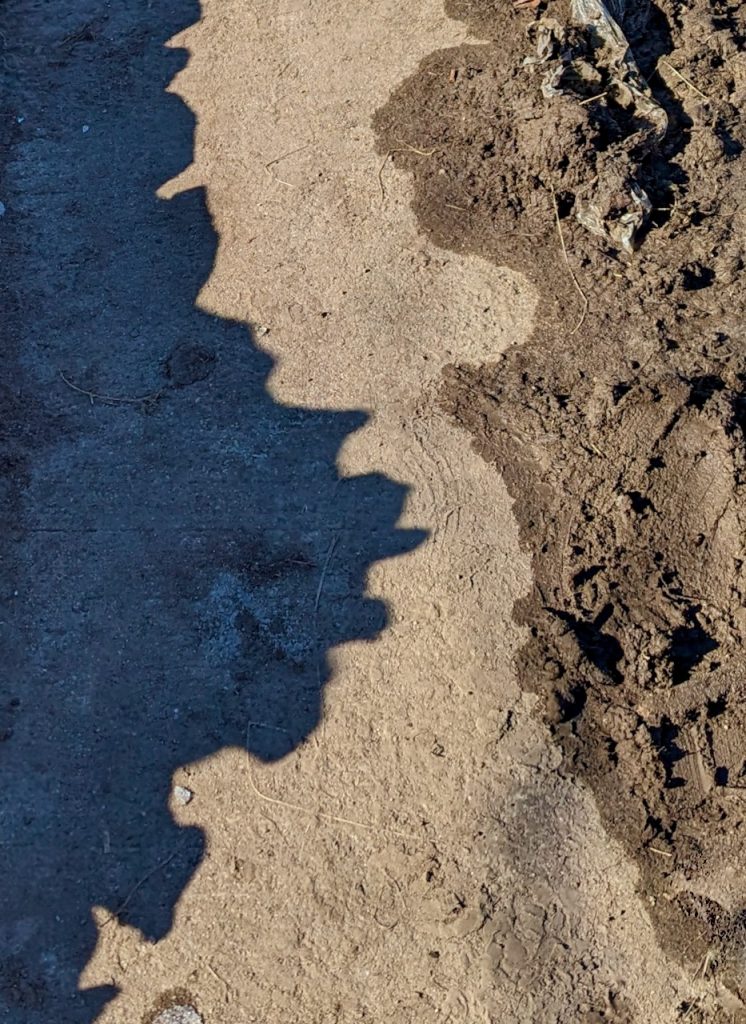
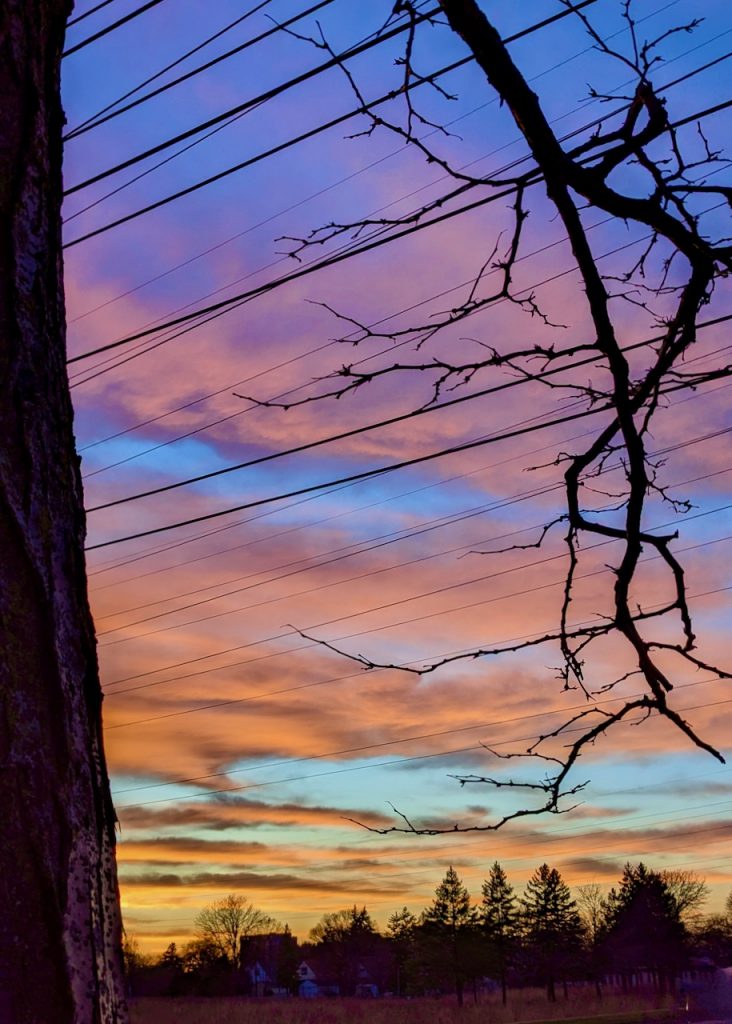
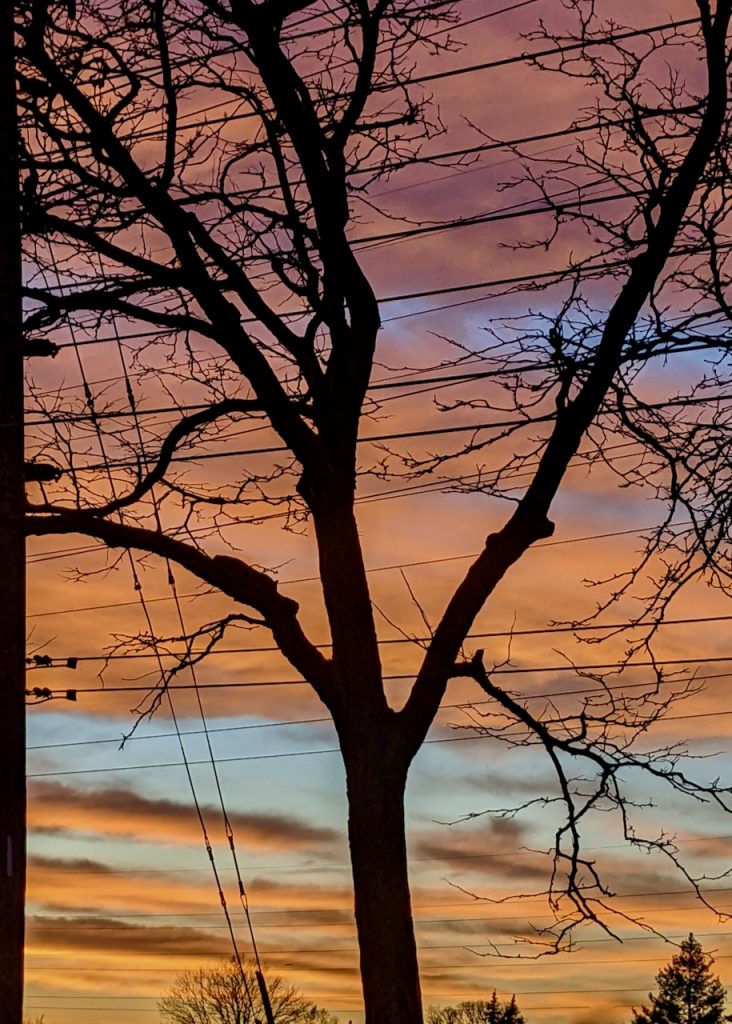
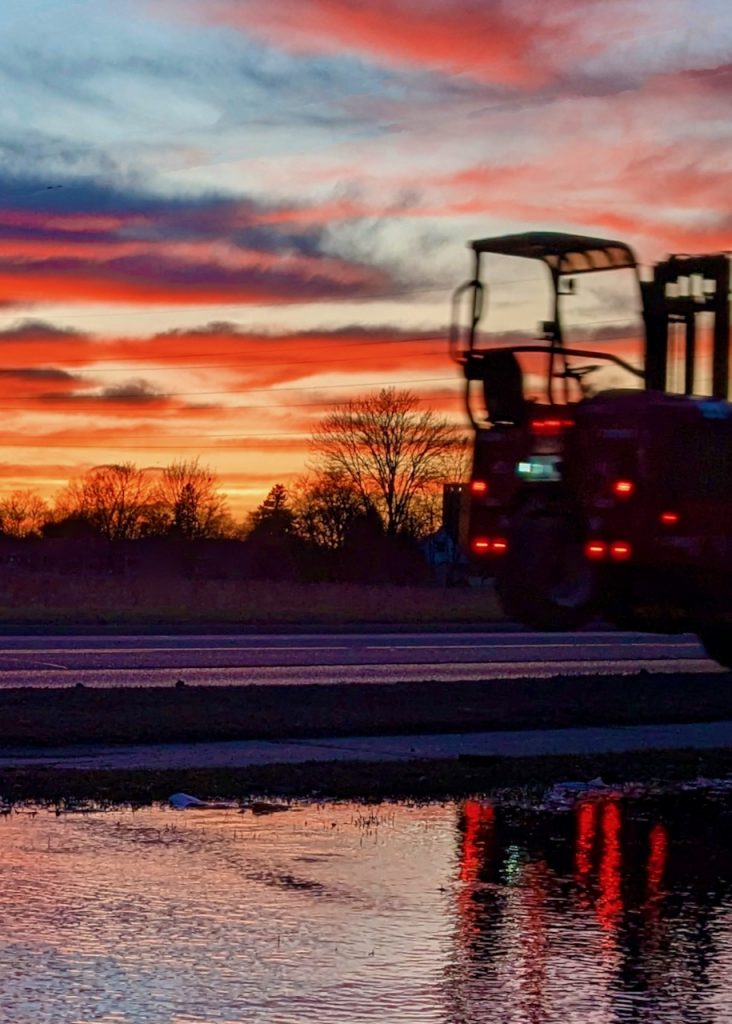
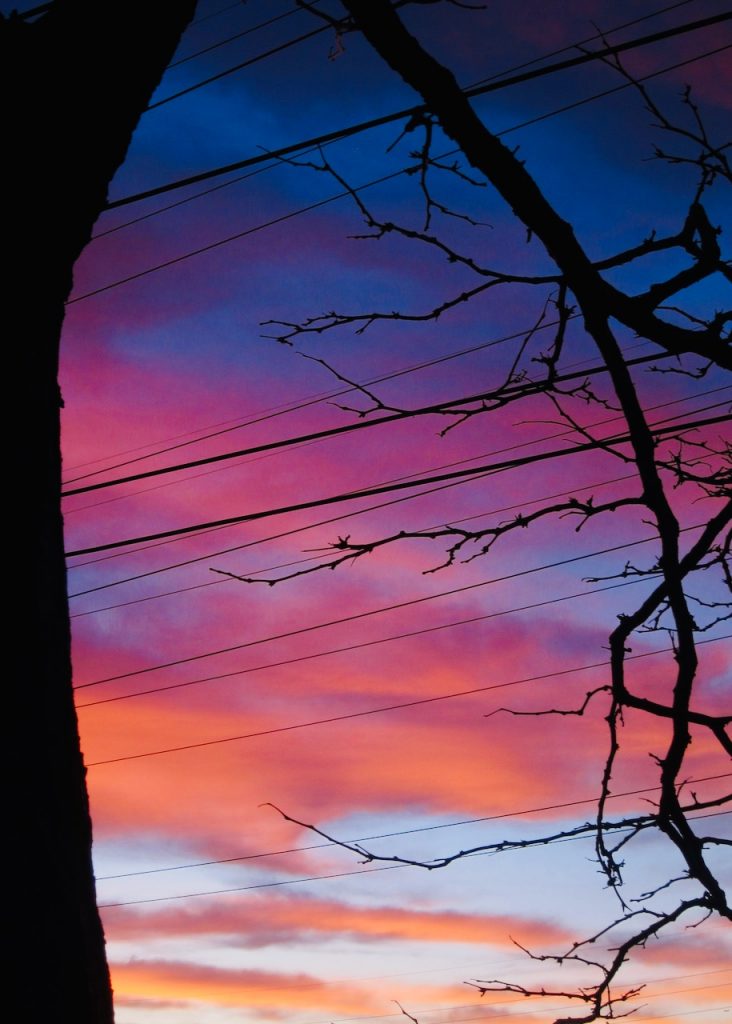
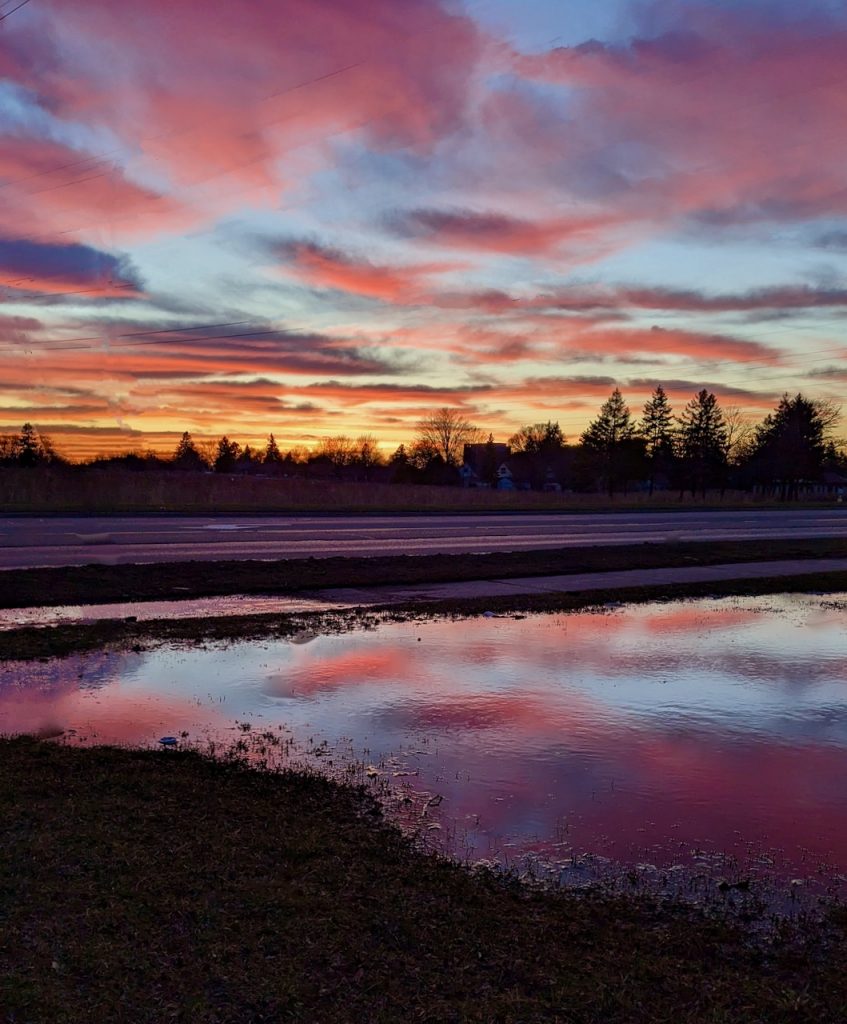
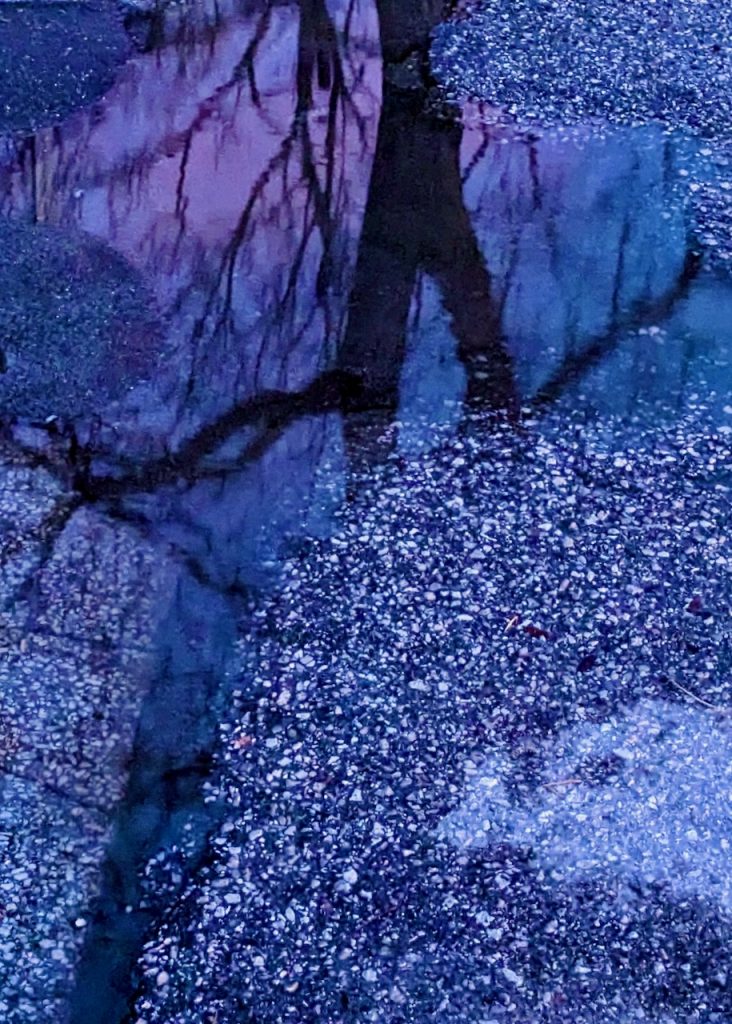
One fall day,
a logical gully
guides me down the slope to Highland Creek.
My steps disturb a creature
who escapes under the cover of leaves,
defining a ribbon of movement
that lifts the rustling shelter as it flees.
With anonymous grace,
the animal testifies to life unseen but more real than this poem,
fusing threads of instinct without pause.
One summer day,
I cycle home from the college on Ashtonbee Road,
thoughts distracted from the simple path
that curves by the banks of Taylor Massey Creek.
I pass a tall gathering of yellow grasses
that erupts with red winged blackbirds.
They fly straight up from the reeds,
rising in a startled mass of flapping.
Like verses that nest unknown within us,
it takes a sudden whoosh of wheels or wings
to show life at its roots, a wild relentless freshness
that we cage with fear.
One spring morning,
dark green shoots
grow from my breasts, pushing up, pushing out.
Cautiously, I tug a shoot from my left aureole
and a curly leaf unfurls in my hand.
I tug more leaves and yet more leaves,
shocked by the secret depth of my roots.
Raw soil spills over my fingers,
and one last strong yank
yields a golden onion.
My vegetable offering
hints at the body’s food, the push of streams,
breath of reeds, and the resilient moss veiled by fallen leaves.
I believe in succulent roots
that answer winter prayers of the famished
who trace patterns of desire on the waiting Earth.
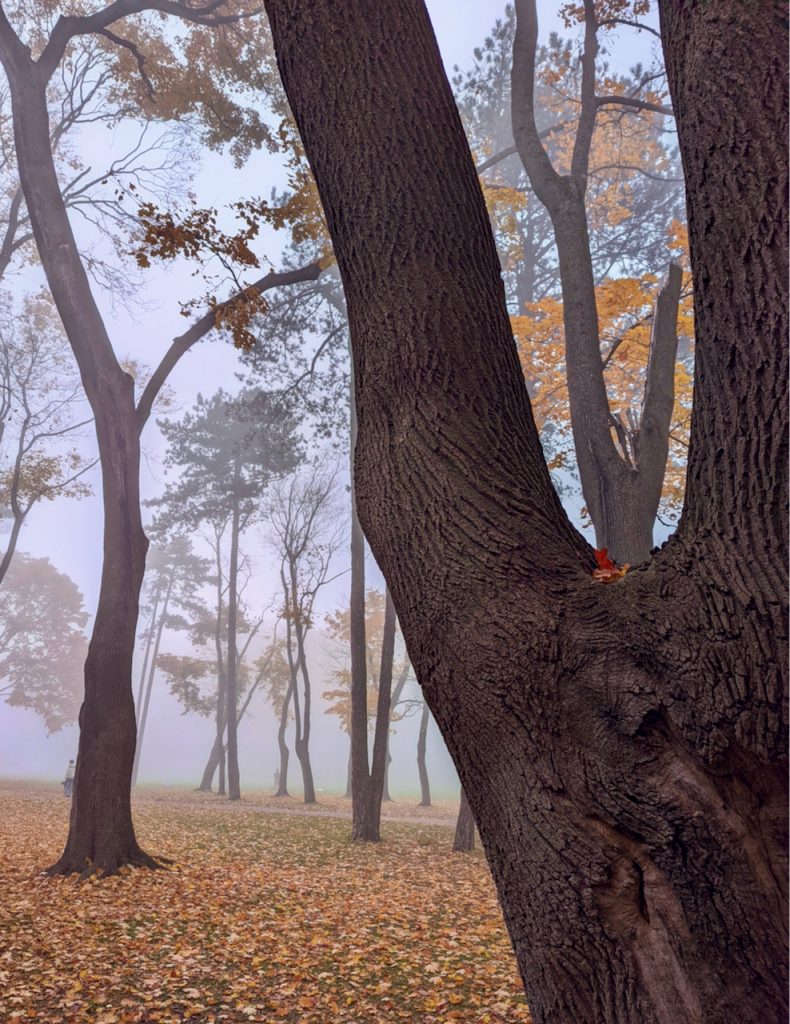
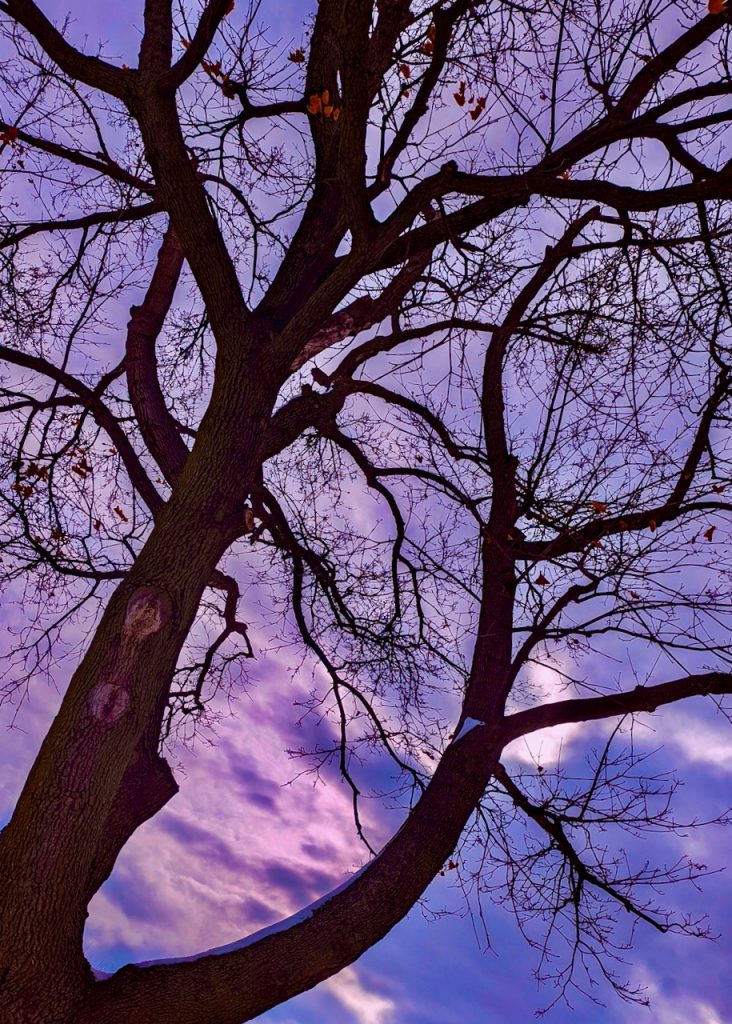

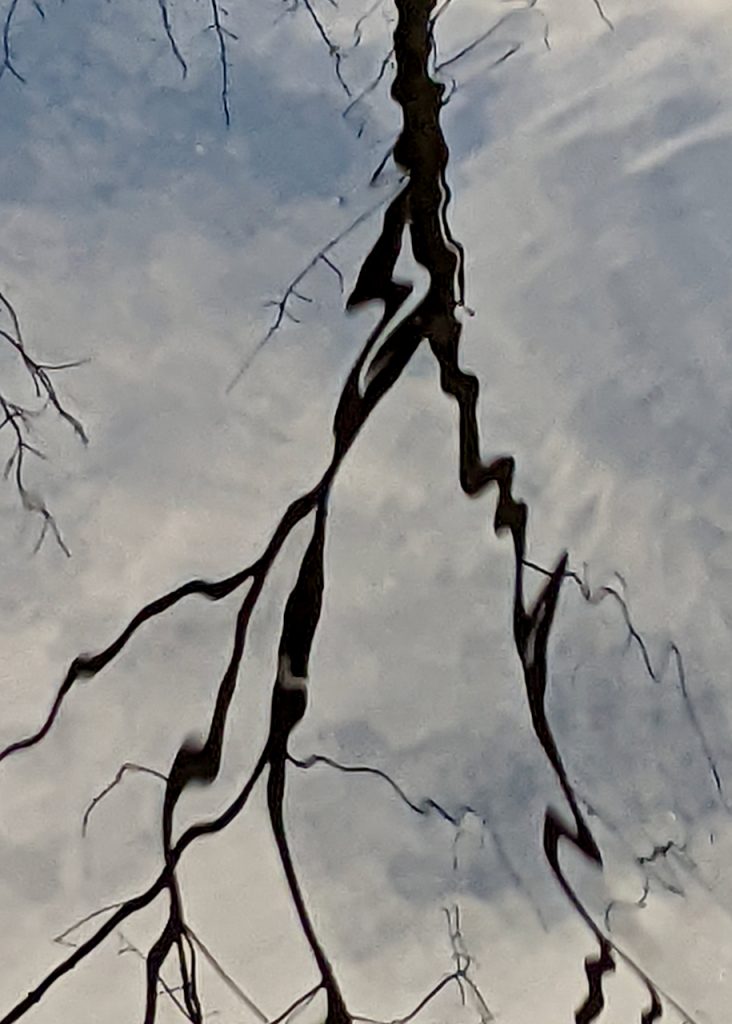
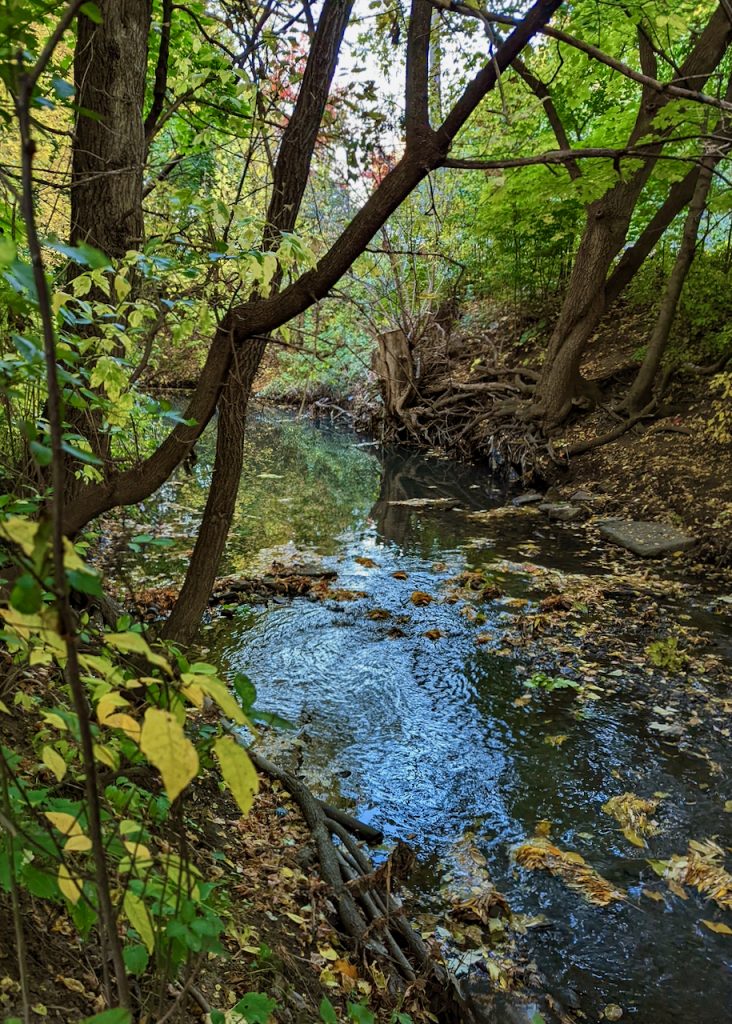
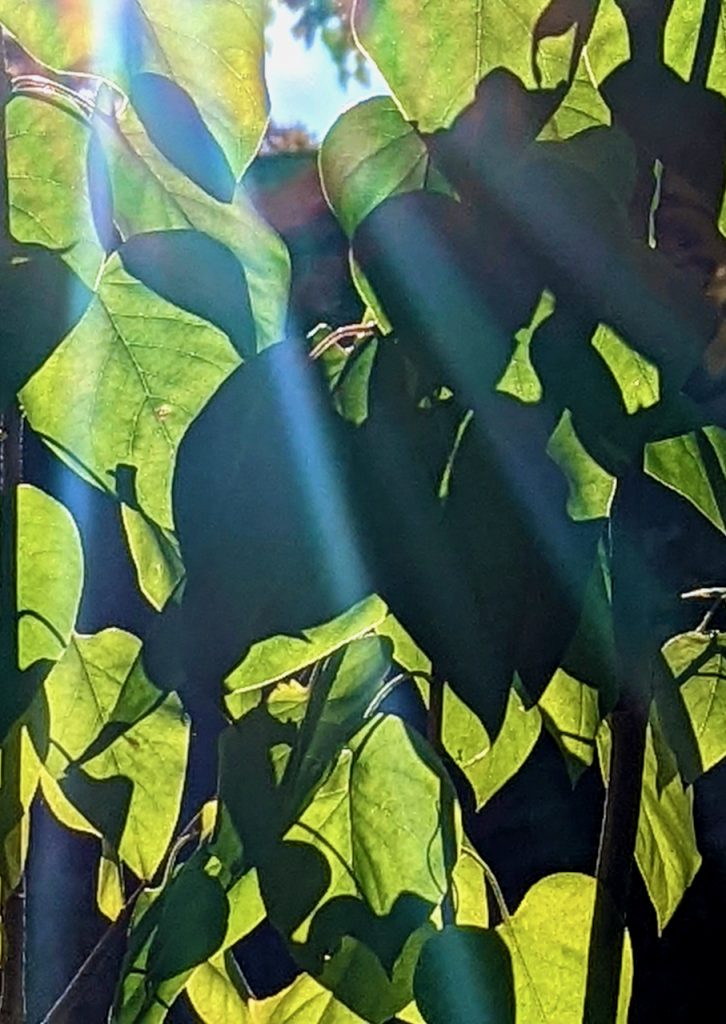
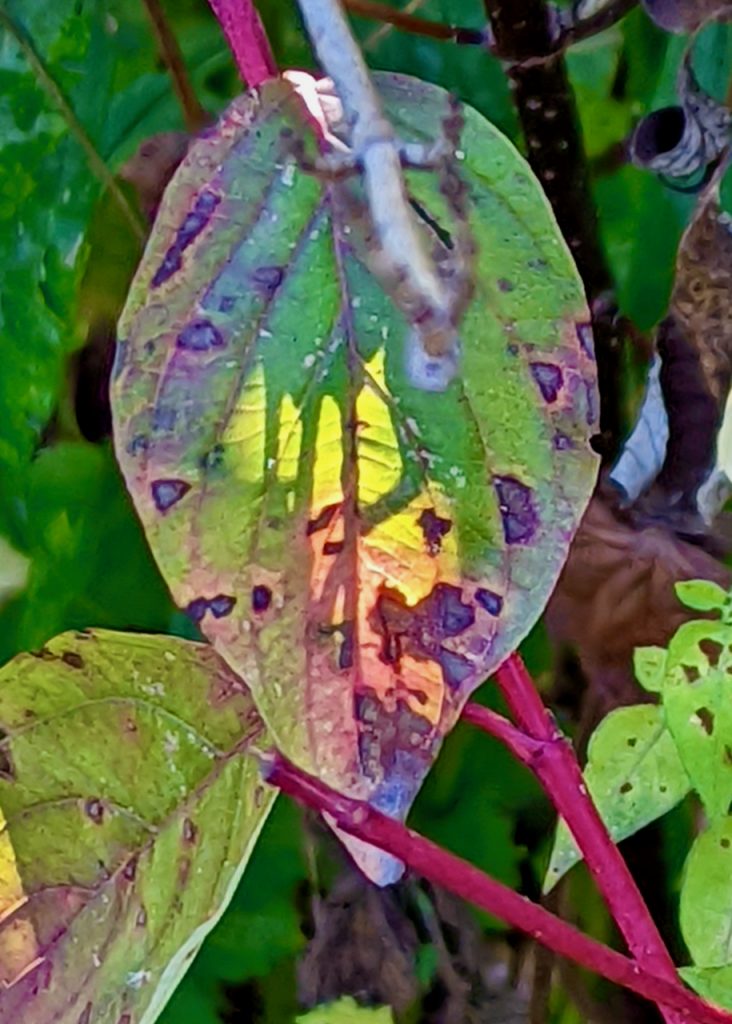
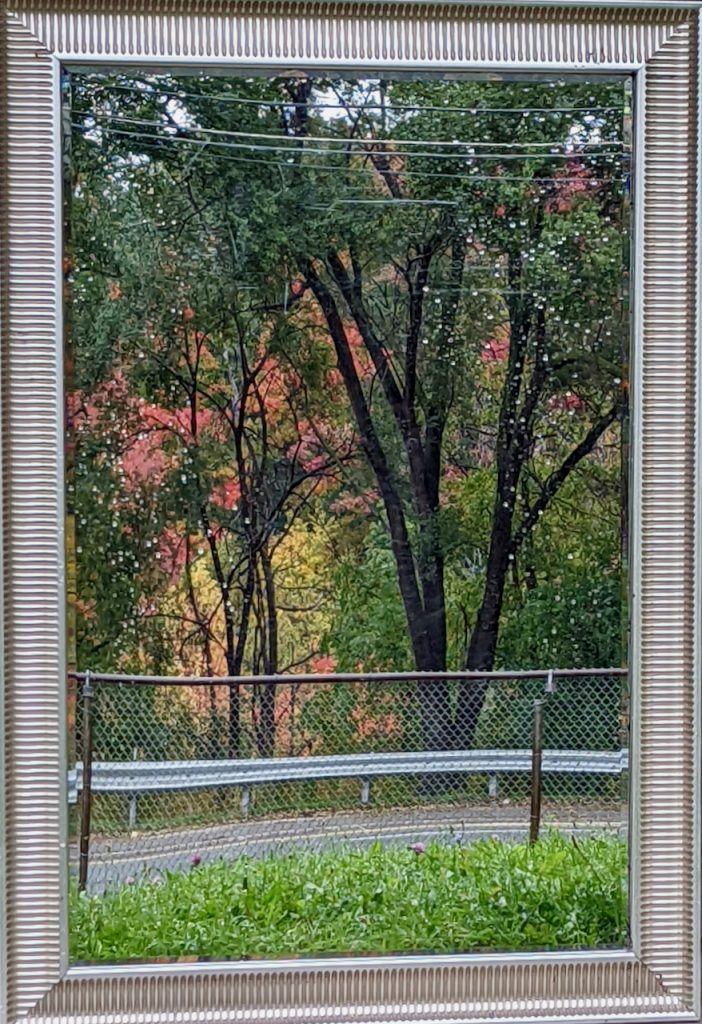
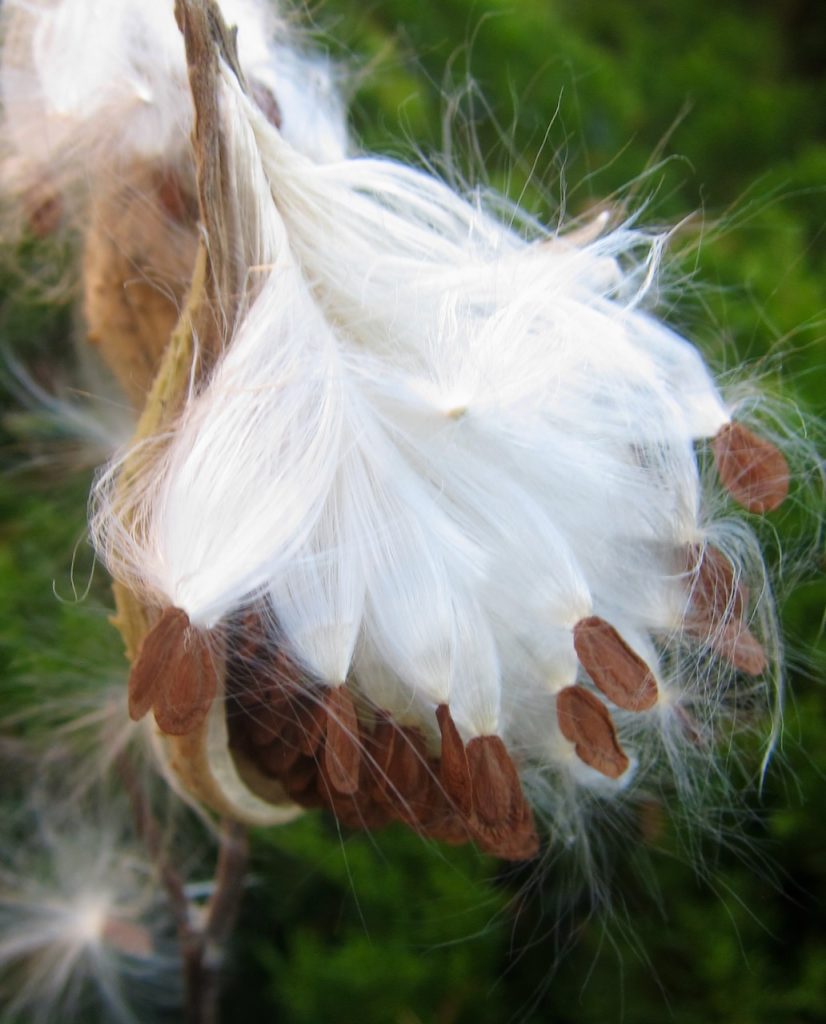
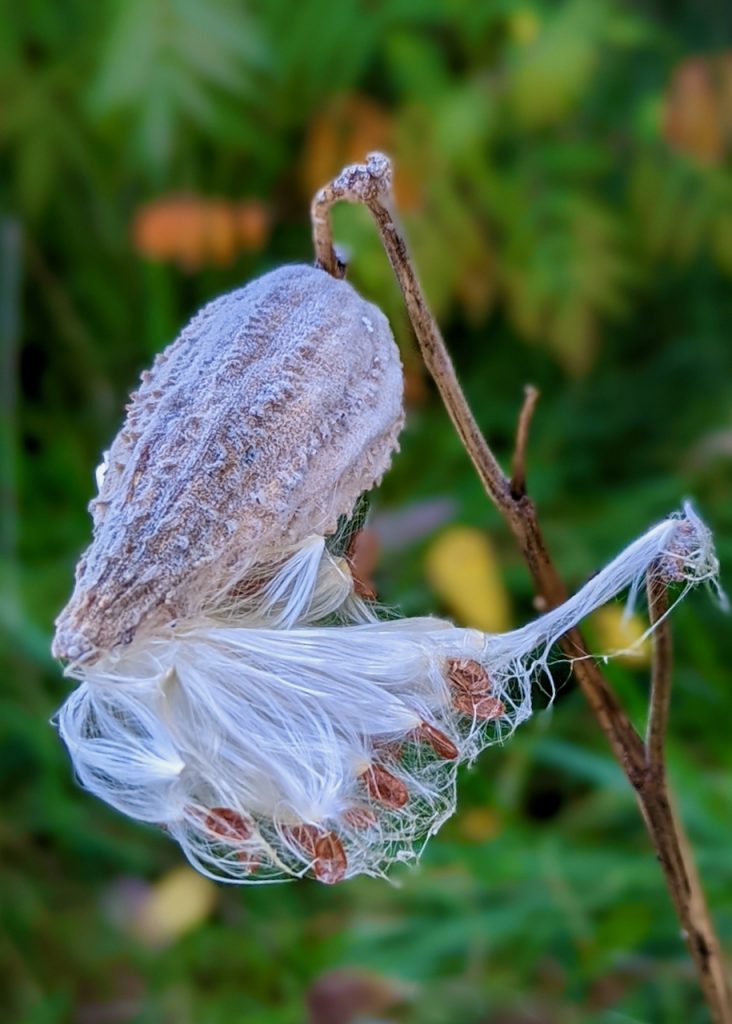
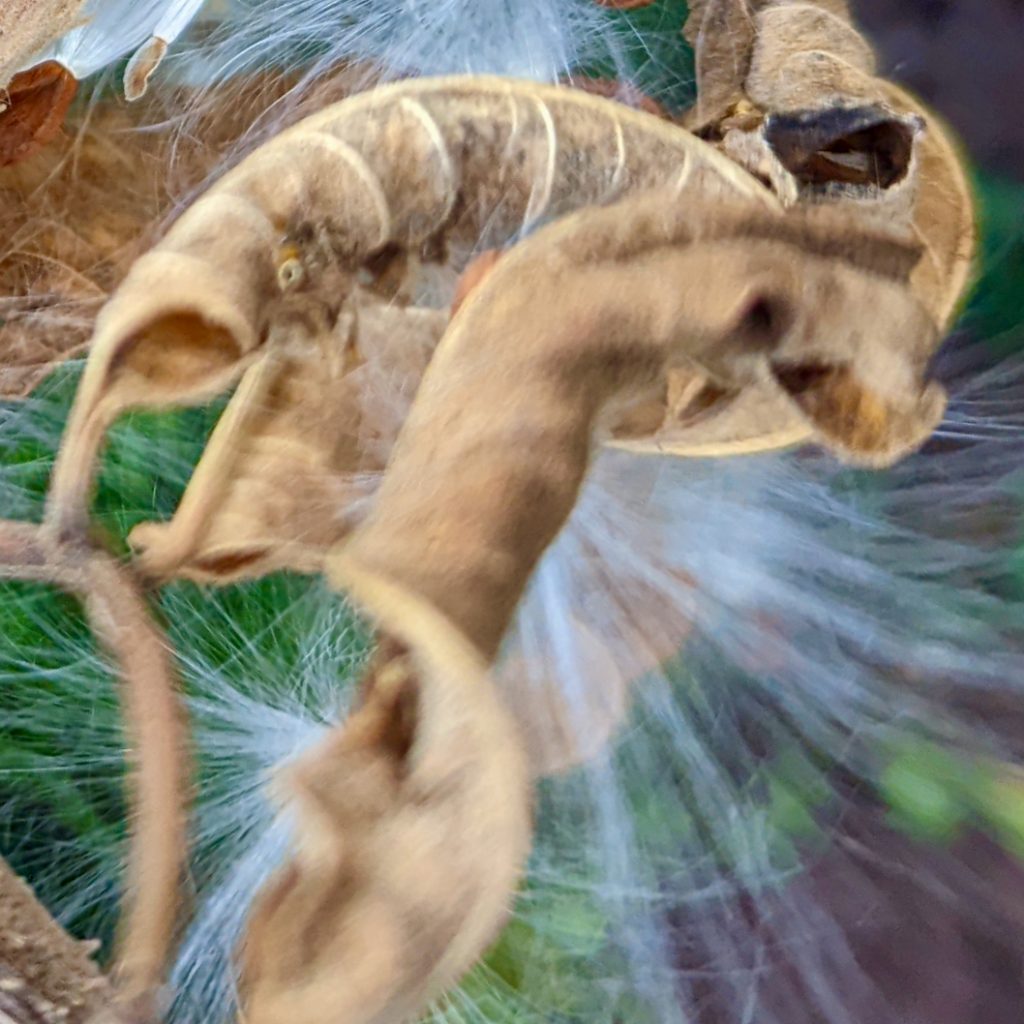
Your anguish is a force, a separate soul that cries out for solace and remedy. A thousand words of comfort rise from the ache in my throat, but they cannot restore the beloved person who abandoned you. Into this void, my voice may drop like a stone.
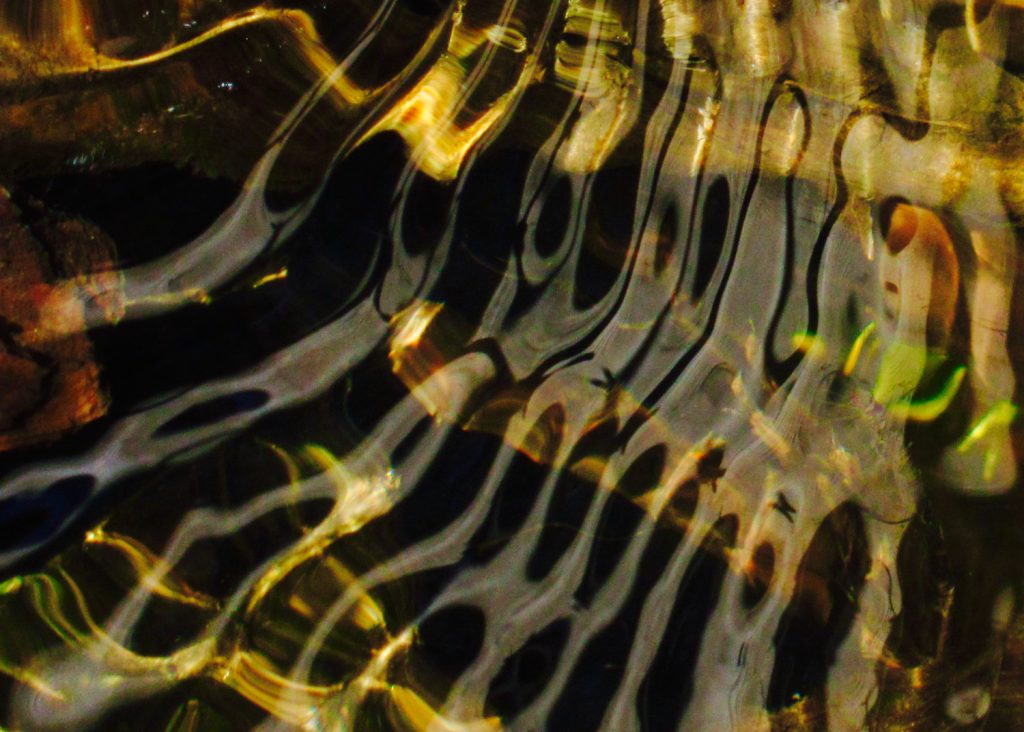
It hurts to see you cry, face in your hands, unable to sleep, eat, or even feel real. Dizzy from the shock of sudden desertion, each second refuses to pass, remains incomplete. Your injured heart has lost its rhythm and your movements seem leaden, as if masses of melted tar are dragging your arms down every time you lift a glass.
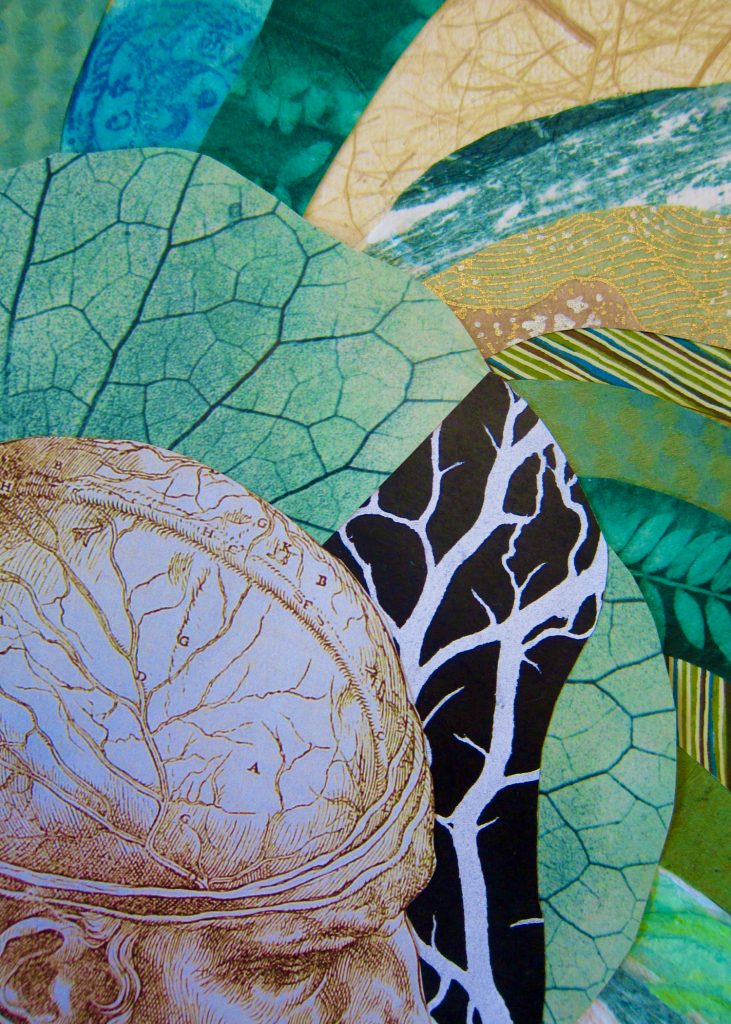
While your body slows to glacial time, the brain accelerates as it struggles to comprehend this alien reality that cannot be happening but is happening anyway. Like a never-ending game of tether ball, your thoughts spin faster and faster into smaller and tighter circles, shackled by panic to the iron fact of loss.

If I had the power to heal you, I would gather the softest banana leaves in creation and soak them thoroughly in shea butter. Then I’d wrap them round your head to cool and cradle your brain, drawing out the poison of self-punishing thoughts, soothing the pain, and smoothing the wrinkled loops of endless tormenting questions.
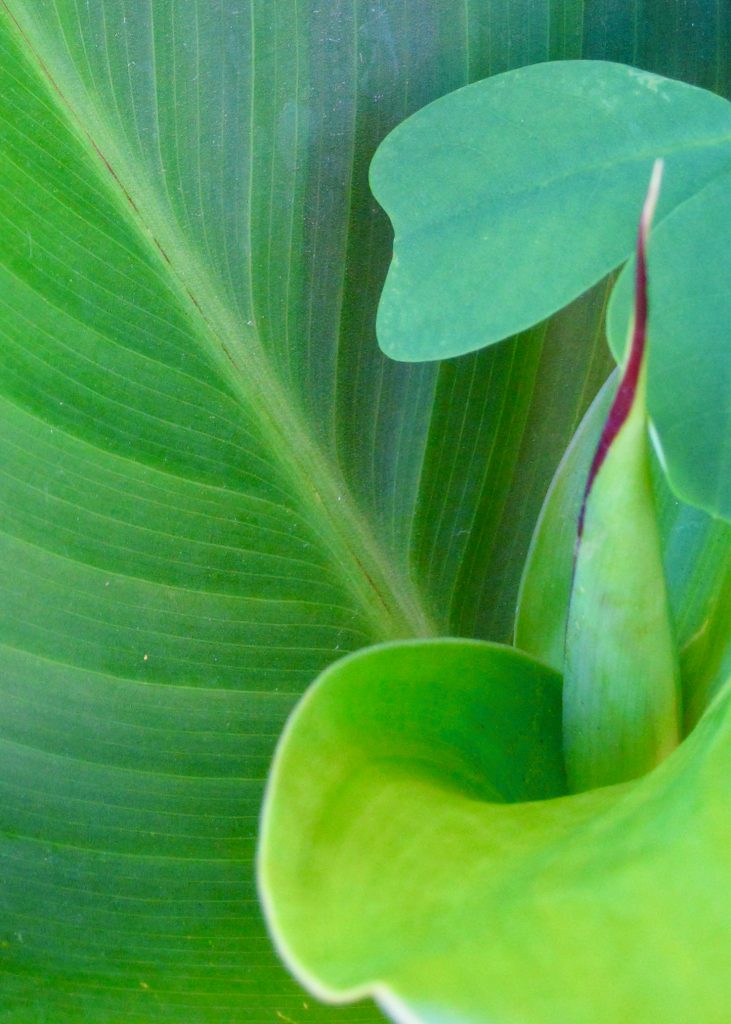
For your heart-wounds, I offer a poultice composed of clay, feathers, and ferns to press against your chest as if in prayer. The heart-poultice cannot mend the cracks, but it honors them with love. When the minerals and soft coverings touch your skin, they ease the hurt, giving you precious minutes of relief.
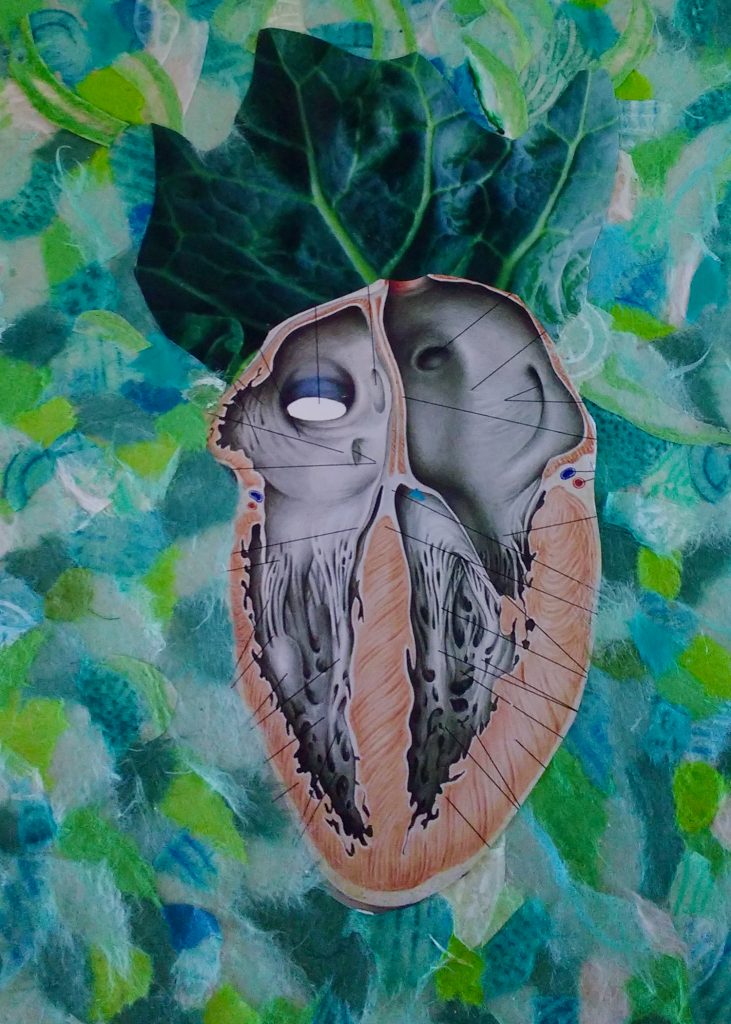
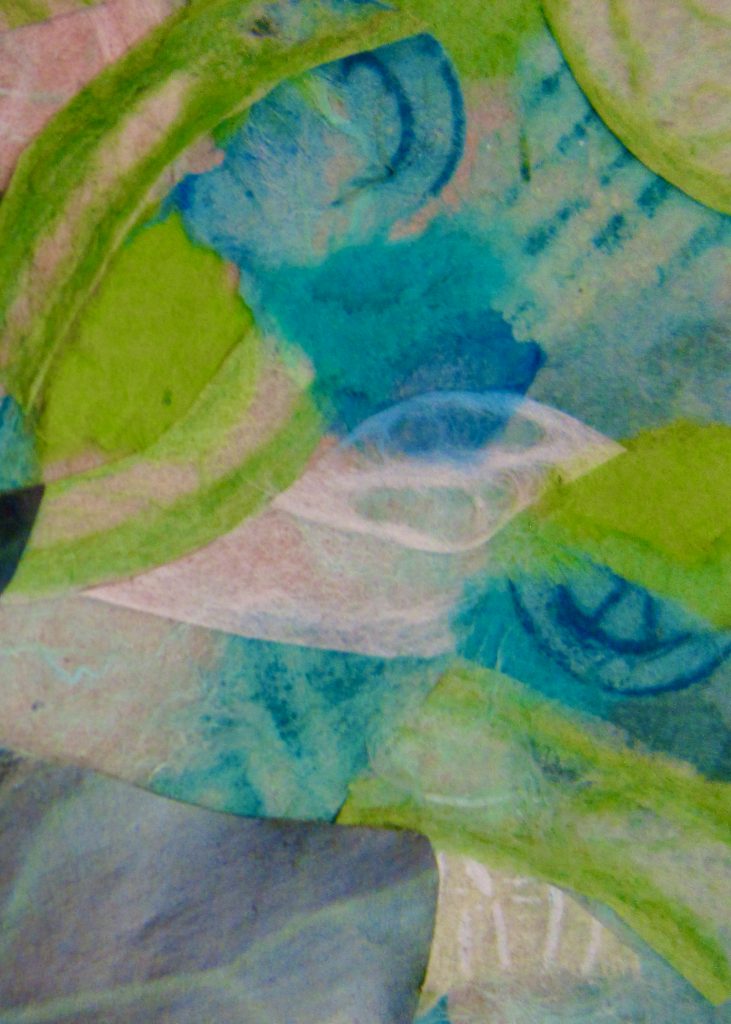
And for your whole body, a pool has been sunk into the cursèd room that most haunts you with memories. The pool is not very wide — the width of three ordinary bathtubs — but it is fathoms deep. The sides and bottom of the pool are made of peat-black marble, turning the water so dark that it gathers you into oblivion. When you sink into this personal well, the only things you experience are the present sensations of cool healing water, your steady breath, and the kind red beating of your heart.
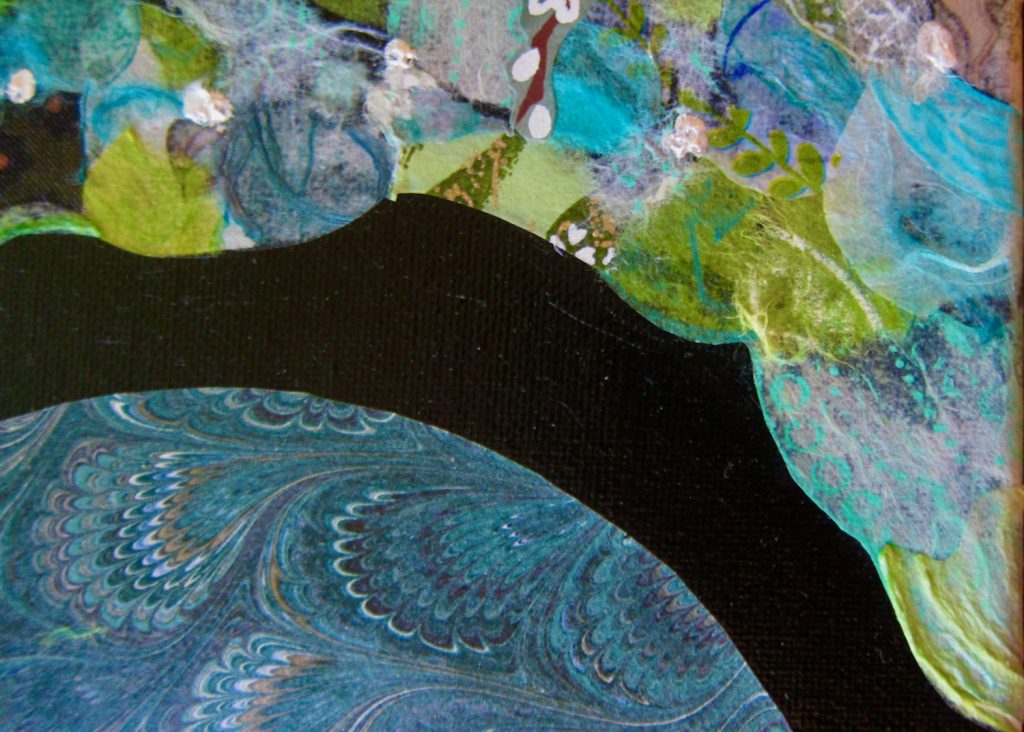
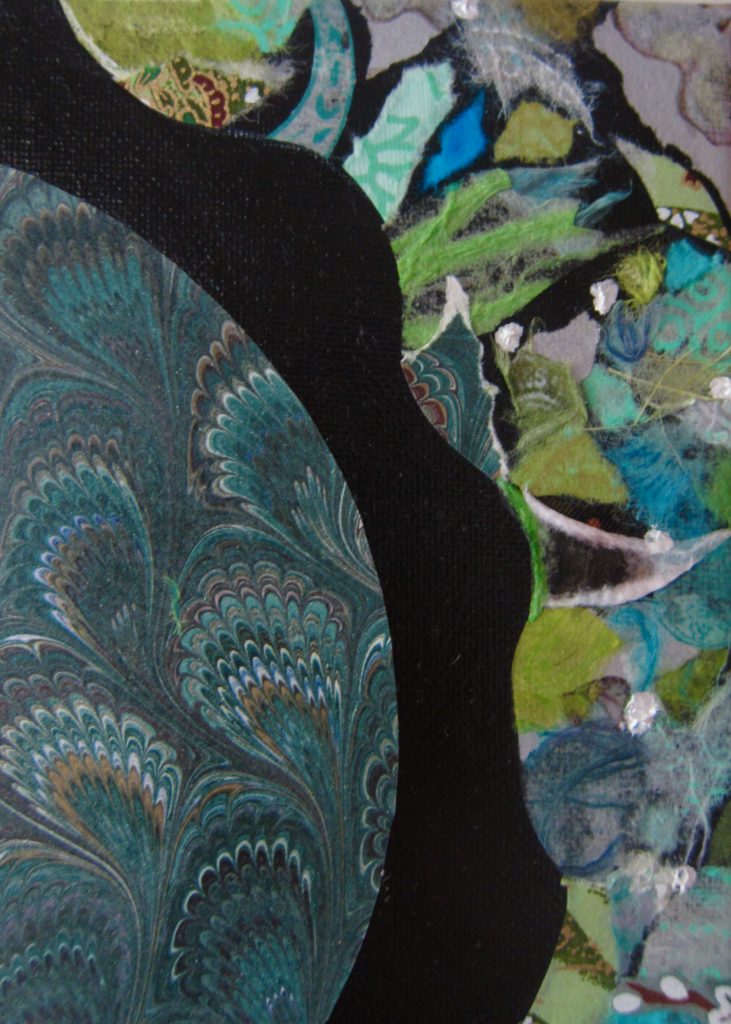
(Thank you Sean McDermott for making the recording! For a physical or digital copy of Visualizations for Heartbreak, please contact Catherine Raine at cafrinie@yahoo.ca).
On a winter evening in 2011, I attended “Calling All Artists!” at Northern District Library. The massive turnout filled a huge meeting room and had staff scrambling to add rows of chairs to accommodate all the Toronto artists eager to learn more about exhibiting their work at the Toronto Public Library.
Four speakers talked us through the application process. The person in charge of TPL’s Art Exhibits went over the application form in detail. Greg Astill promoted the services of the popular Digital Design Studio at the Toronto Reference Library. Then we learned more about displaying our art to its best advantage from Carol Barbour, TPL Gallery and Exhibits Curator. Finally, Susan Cohen discussed the business and marketing aspects of the art profession. She generously gave us the benefit of her experience as Program Director for Cultural Careers Council Ontario.
I took away many helpful ideas from the information session, but two of them stand out the most.
First, Ms. Cohen emphasized the crucial importance of a clear and concise artist’s statement: “You need to know exactly what you are doing and why you are doing it.” If our marketing vision is not clear to ourselves, how can it be clear to our viewers and potential customers?
Second, Ms. Barbour advised us to demonstrate strong artistic commitment not only in the careful planning of exhibit details but also in researching the galleries and walls of the thirteen libraries to which we can apply. Our applications will be even stronger if we can make a case for why our work belongs in a particular space. To emphasize this point, one of the speakers said, “For example, large abstract works would not be appropriate for a small, intimate gallery like the one at Yorkville. They would be perfect for Northern District’s Skylight Gallery, though.”
As I was reflecting on the curator’s advice, it occurred to me that my library blog could facilitate the research element of the application process. (For new readers to Breakfast in Scarborough, I have visited, written about, and photographed all 100 branches). The thirteen posts listed below offer glimpses of each library’s unique atmosphere and should give TPL exhibit applicants a sense of which one might best showcase their work.
To check out the specific branches that host community exhibits, please click on the hyperlinks below:
Albion (photos in this branch were taken before the 2017 rebuild)
Oakwood Village Library and Arts Centre
Richview’s gallery was site of my first library art exhibit!
Three cheers for art in the libraries!!!
Once the reality of betrayal shatters the numbness, your rage awakens molten creativity and revives the blacksmiths and glassblowers of old. Your curses blast the forge and explode in the fire, where they transform into a glowing orb with fierce swirls of crimson, orange, and yellow.
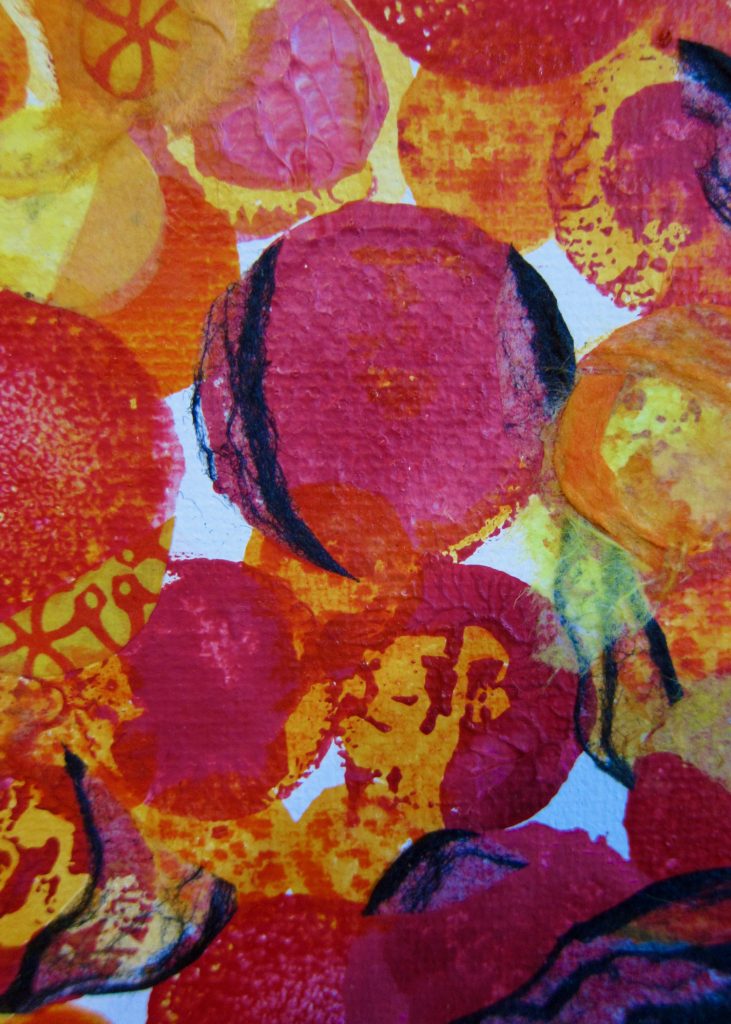
The fiery globe is too hot for human hands to touch, and curious viewers must back away from its dangerous fragility. But when the orb cools, when it settles into itself, thousands will flock to this glass masterpiece, magnetized by its primal beauty.
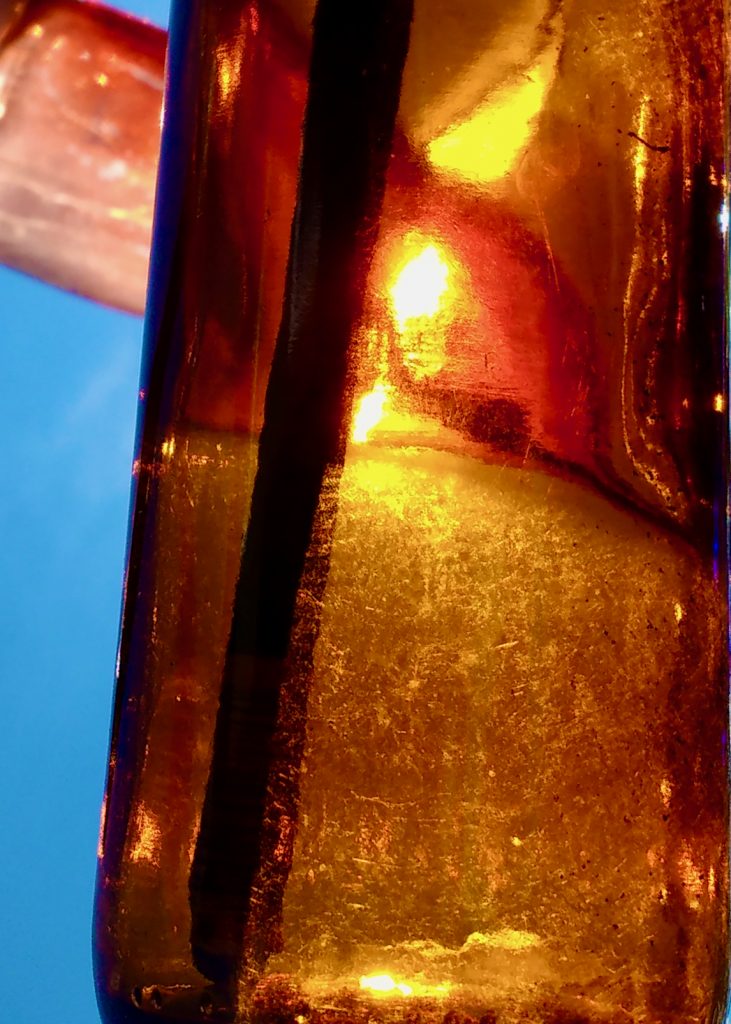
The rage orb electrifies viewers and powerfully connects them to the anger of our hurting world, for this beautiful object has been forged and burned and spun from the rawest materials on earth: the fury of the wronged and the anguish of the betrayed.
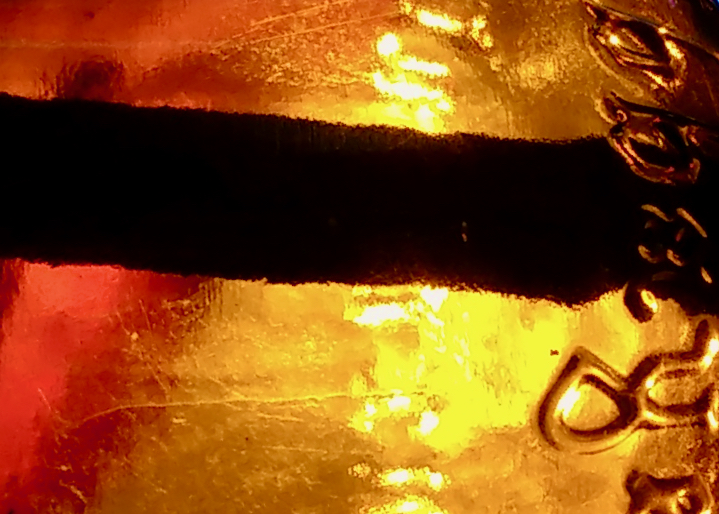
When the orb is tilted at different angles, flashes of violence appear, open wounds that seethe beneath the fragments of a shattered heart. Critics may find your art disturbing or claim it contains glints and flints of revenge, but I say, “No, not traditional revenge or actual violence. Only the satisfaction that comes from refusing to bury pain inside. It takes courage to harness anger’s explosive energy and hurl it into a new form, sowing seeds of fire into grief’s deep furrows.”
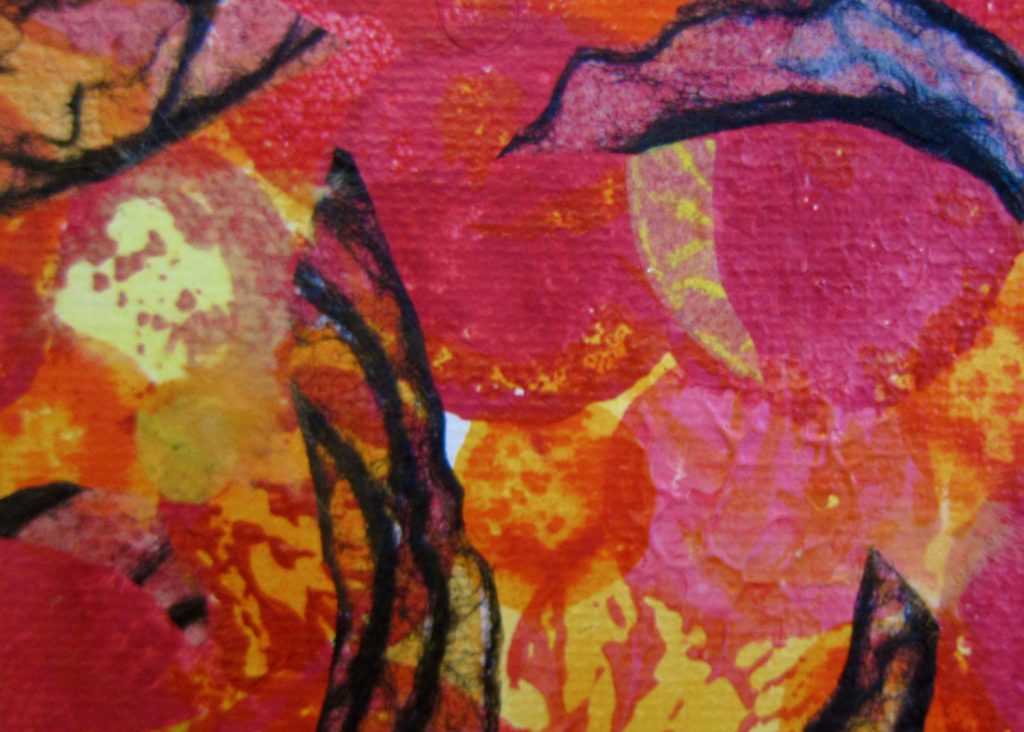
Although the orb’s creation has not exorcised anger for good, it has given you some peace. Its presence is a testament to the value of authentic feelings, no matter how uncomfortable, sharp, or bitter. As you navigate this strange land of loss, you bring rage with you, for it is a righteous guide that divines underground springs of truth.

(Thank you Sean McDermott for making the recording! For a physical or digital copy of Visualizations for Heartbreak, please contact Catherine Raine at cafrinie@yahoo.ca).

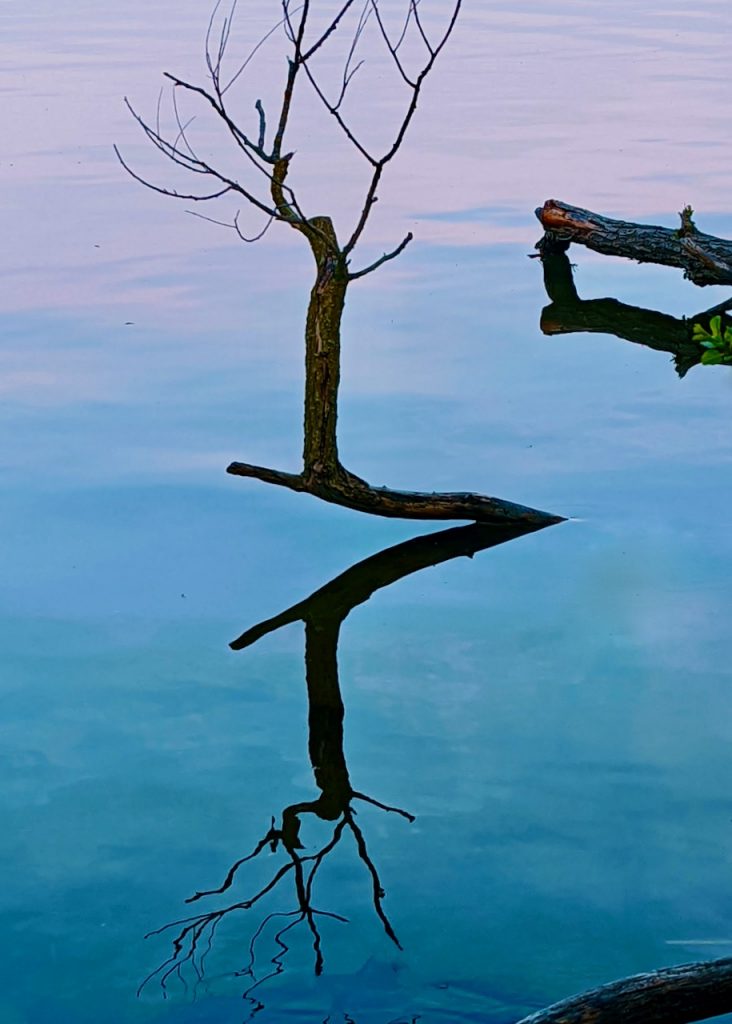
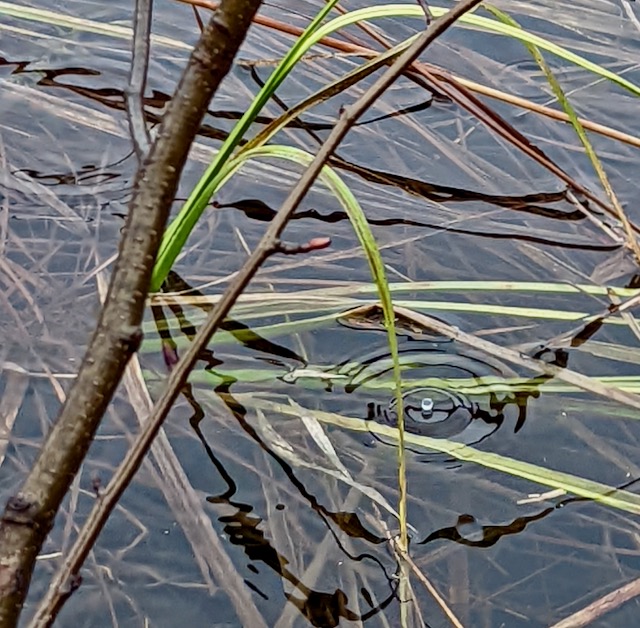
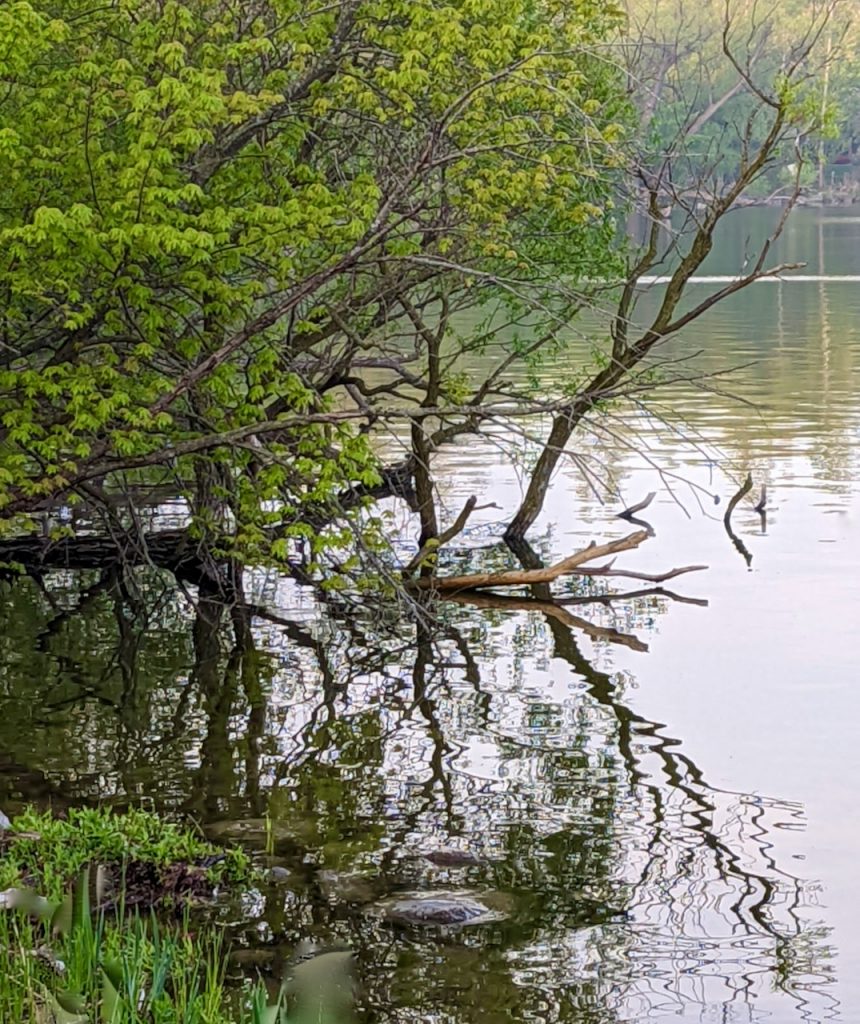
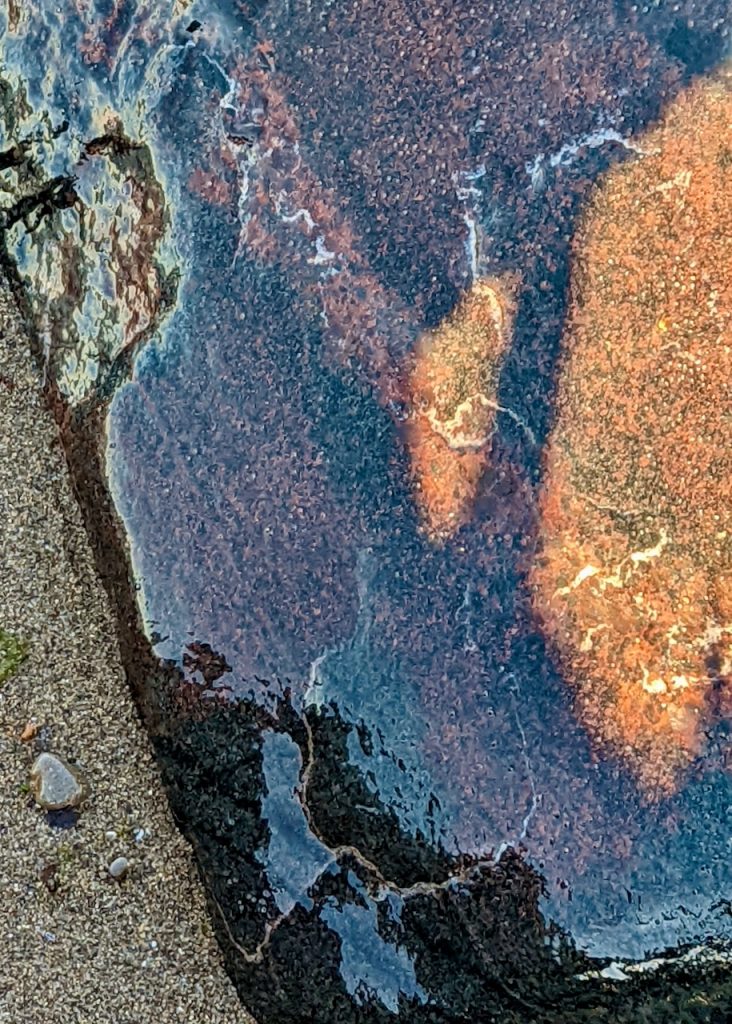
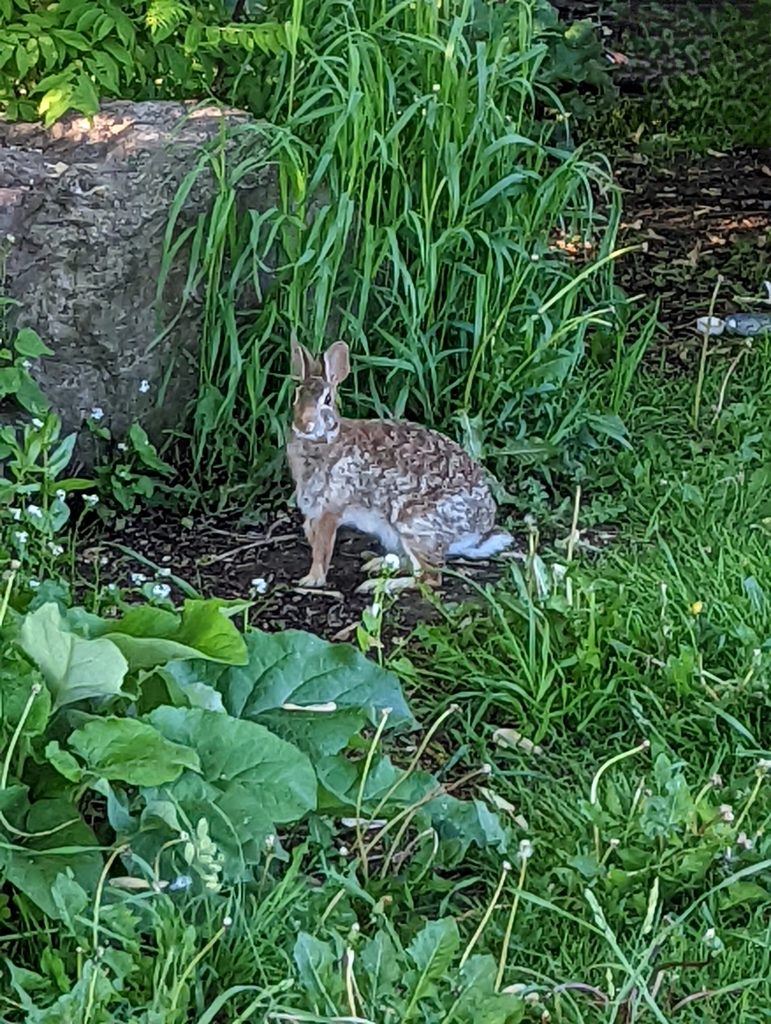
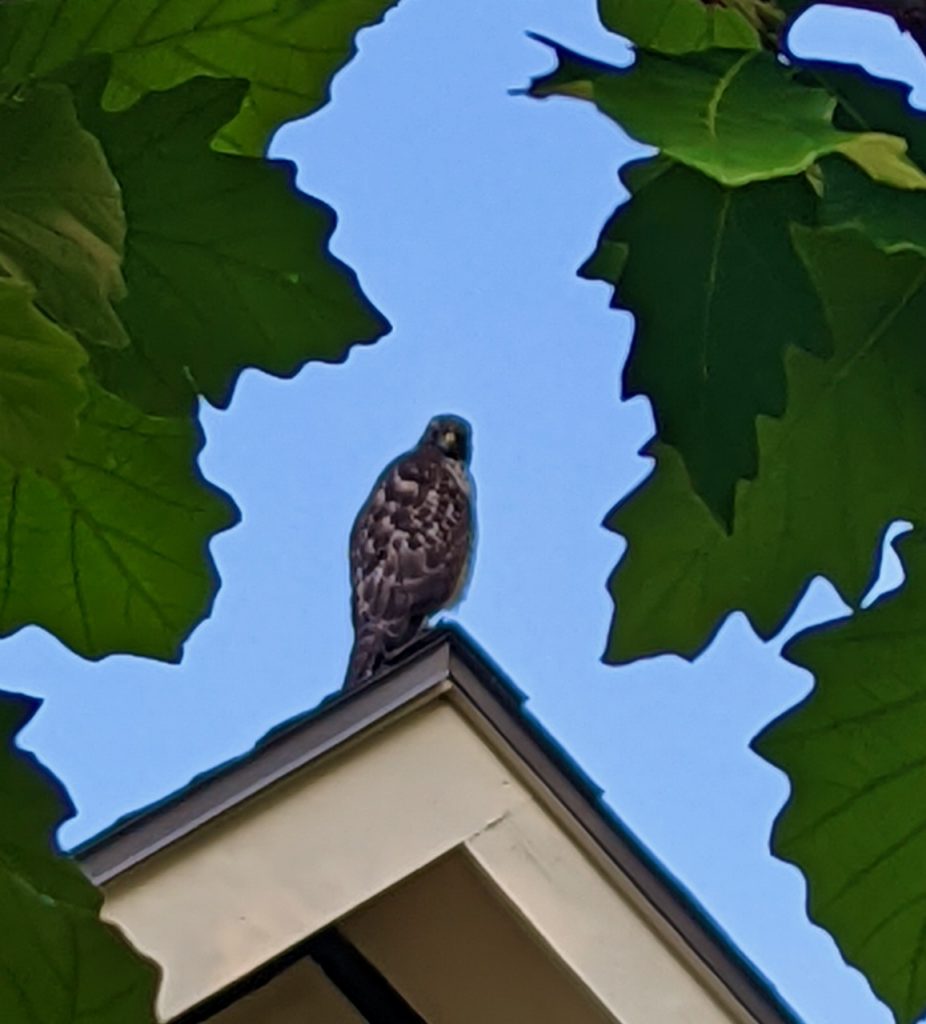

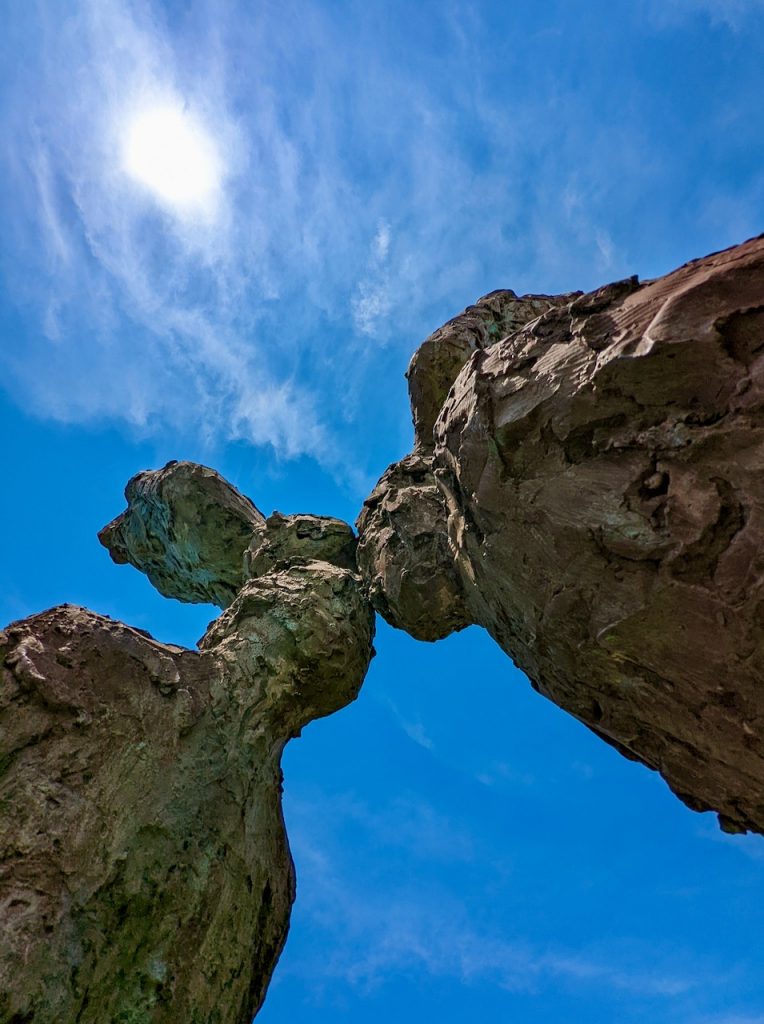
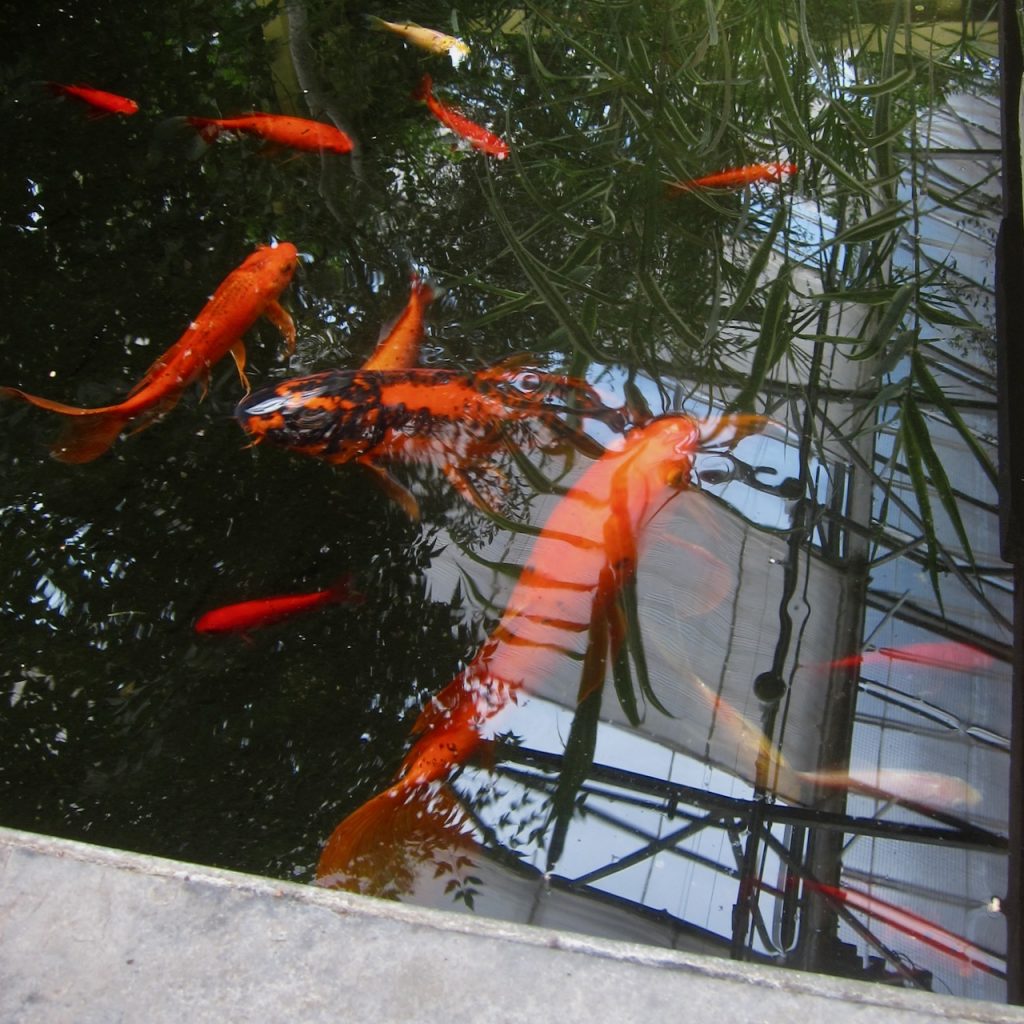
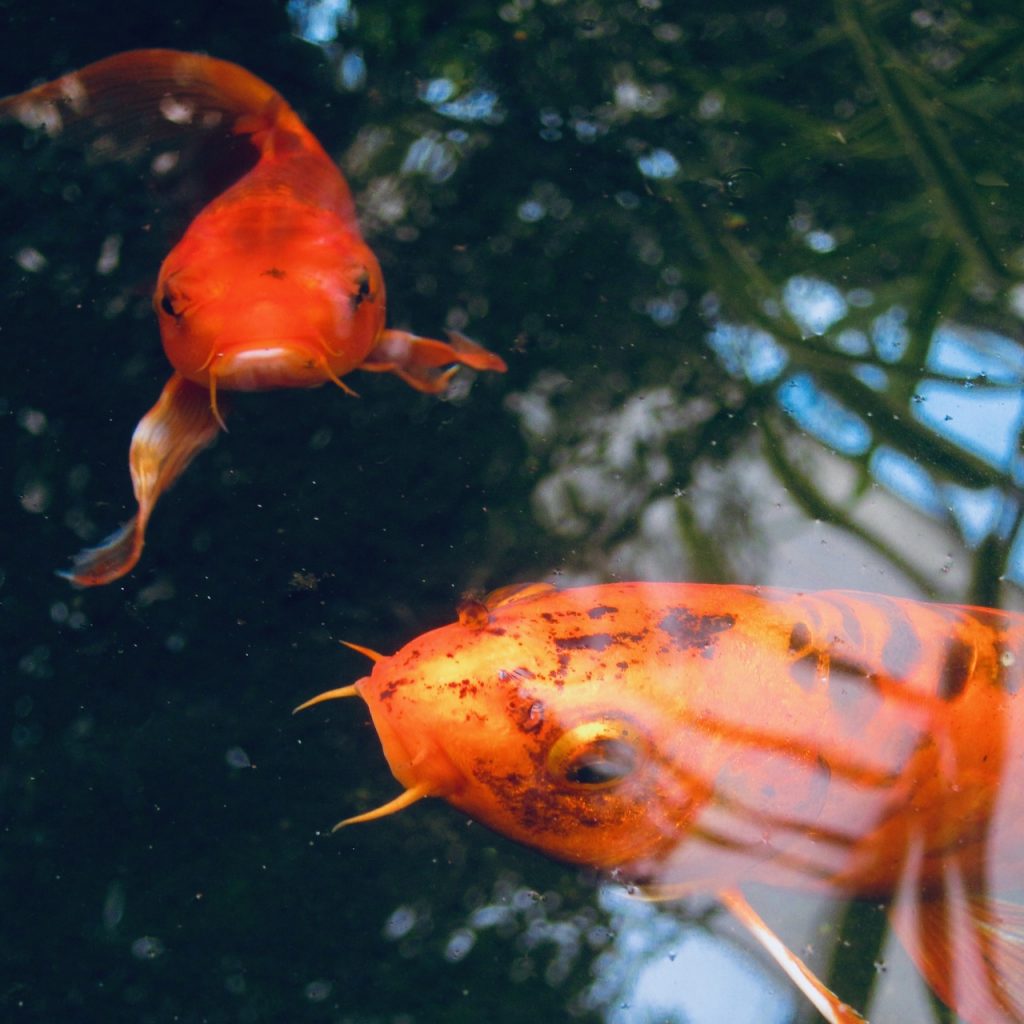
Last December I bought a painted wooden canvas that someone had donated to Value Village. After gazing at my purchase, I decided to follow some of the patterns of the paint swirls, adding tissue paper, thread, dots of acrylic paint, and handmade papers to the canvas.
For example, the dark purple shape in the top left quadrant of the substrate seemed open to becoming the eye of an aquatic creature swimming through waving pink fronds and flowery fragments. Black thread was added to outline the imagined form of the creature, now called Colourfish, and make it more discernible.
To the artist who gave their canvas to Value Village, thank you very much! If you had not lavished the board with violet, lavender, pink, green, and apricot paint, the Colourfish would not have found a habitat so well-suited to its playful temperament.
My friend Ellen made this cloth creature in the Art Gallery of Ontario’s cafeteria one day in 2010. As we talked, she sewed the sweet green eyes and fashioned eclectic ear-gills that poke through the pink mesh.
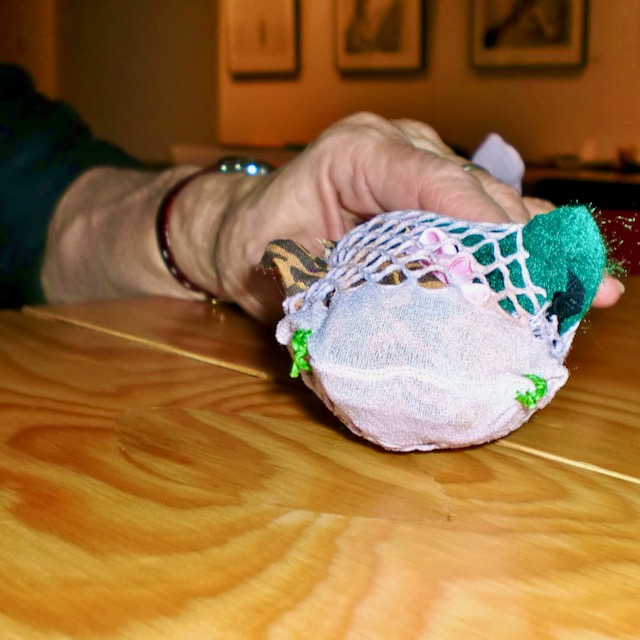
Thread, needles, fabric, ribbons, and socks spilled from two bags I had brought from home, and our heads bent over our work as we talked.
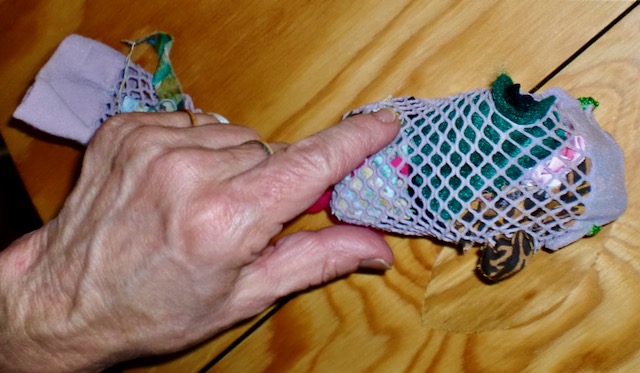
Before we left the gallery, I took some photos of Ellen’s creation. I love how her hand both protects and presents the sockfish. Animated by playful colours and textures, its energy is bright.
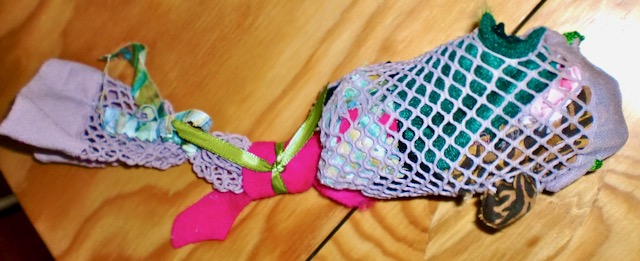
Expressing movement, personality, openness — it seems eager to be on its way, tail swishing in the current.
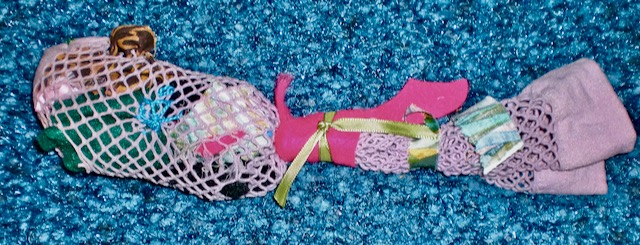
I treasure the memory of that artistic afternoon with Ellen and all the times we met to write, make collages, or exchange ideas. With character, originality, and grace, she practiced friendship as an art form. I’ll never forget Ellen’s creative and loving heart that continues to bless. I miss my dear friend.
I bought Philip and Stephanie Carr-Gomm’s The Druid Animal Oracle Deck in 2008 in hopes of developing collage workshops based on animal teachings. My friend Ellen Jaffe, a poet and teacher, found the idea interesting, so we gave the deck a trial run at a yoga studio, each of us selecting a card at random without looking at the illustrated side. I chose Wolf.
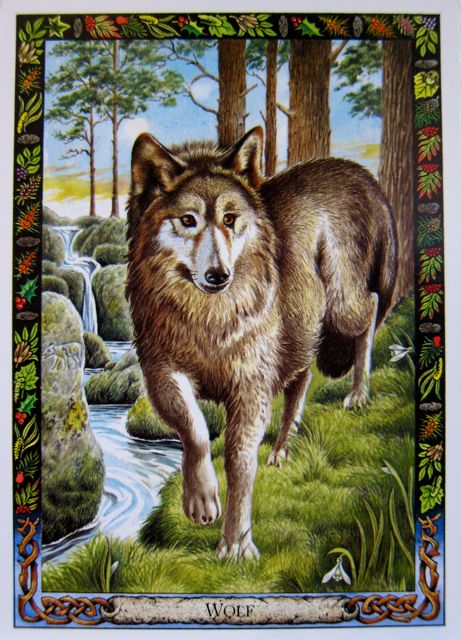
After Ellen made her selection, we took turns reading from an interpretive booklet provided with the deck. From the section on Wolf, I learned that its keywords are “Intuition, Learning, (and) The Shadow” and that Wolf encourages us to honour “the inner power and strength you feel when you spend time alone” (p. 22).
Following a discussion of the teachings, I pulled out a folder of images that I had collected for the animals contained in the deck. Each animal had its own transparent sleeve full of pictures, and from Wolf’s sleeve I selected a few photos for my collage.
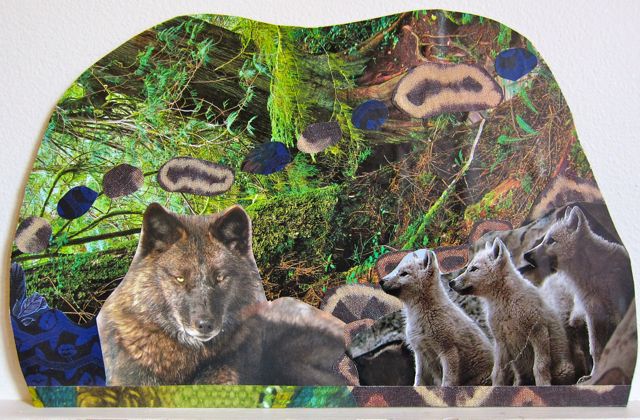
Having enjoyed our artistic experiment with The Druid Animal Oracle Deck in 2010, Ellen and I decided to offer a workshop called “Collage Your Animal Spirit Guide” at a music therapy facility in 2011. The session took place in Hamilton, Ontario and opened with all six participants selecting a random card. After reading aloud from the booklet about the selected animals, everyone received a set of pictures on which to base a collage in addition to backings, scissors, and a glue stick.
As we settled into our work one by one, minds humming in collective concentration, a silence like a seventh presence filled the room. After an hour of tearing, cutting, shaping, and gluing, we shared our artwork, celebrating each piece in turn.

Otter was my personal animal guide that day in Hamilton. According to Carr-Gomm’s explanatory booklet, Otter “invites us to play, to ‘go with the flow’ of life and experience — to become a child again” (p. 32).
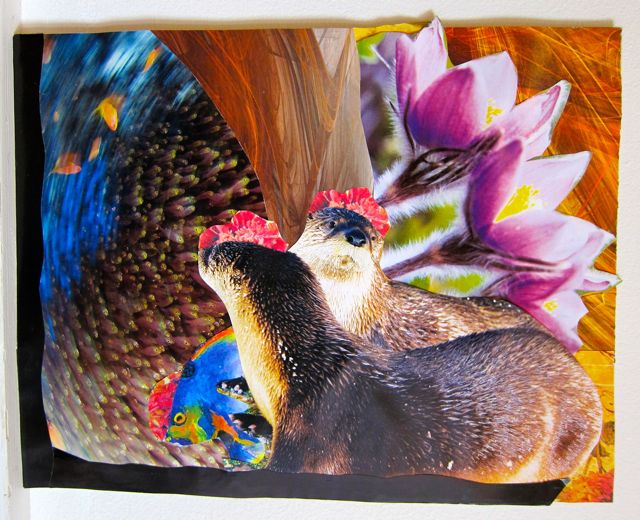
To suggest flow and movement, I included swirling fish and active grasses. For playfulness, I gave the otters and their fish friend some red flower hats.
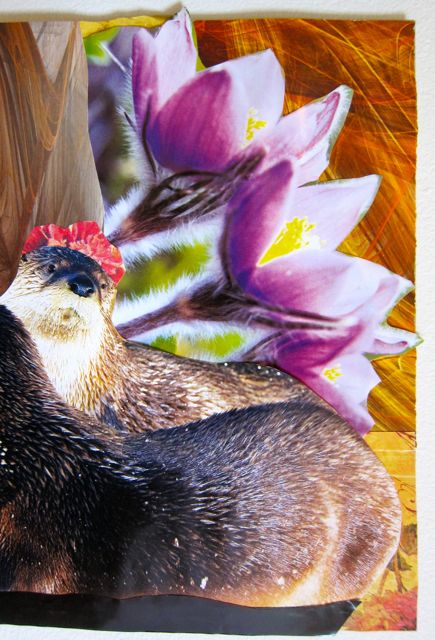
In addition to art sponsored by Wolf and Otter, seven other collages have been inspired by engagement with the Druid Animal Oracle Deck. After a gap of two years, I retrieved the deck when my mother was visiting me in Toronto. This time, Eagle rose up from the pool of cards laid out on my kitchen table. (Mom selected Hawk).
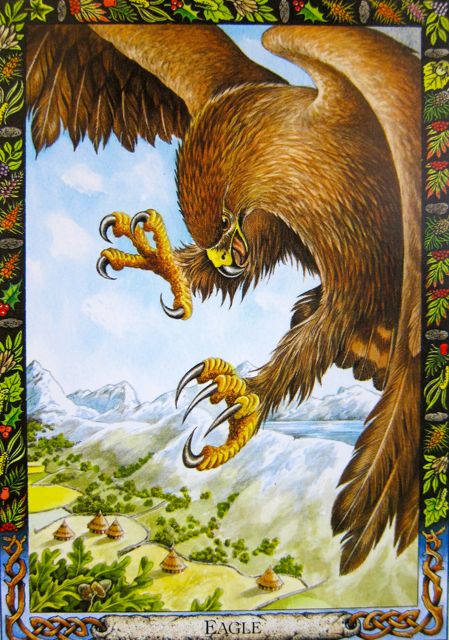
“Intelligence, Renewal, (and) Courage” are Eagle’s key words, and the booklet further asserts that Eagle “will . . . show you how to renew and rejuvenate yourself, by demonstrating the art of plunging — at the just the right moment — into the lake of the heart” (p. 24).
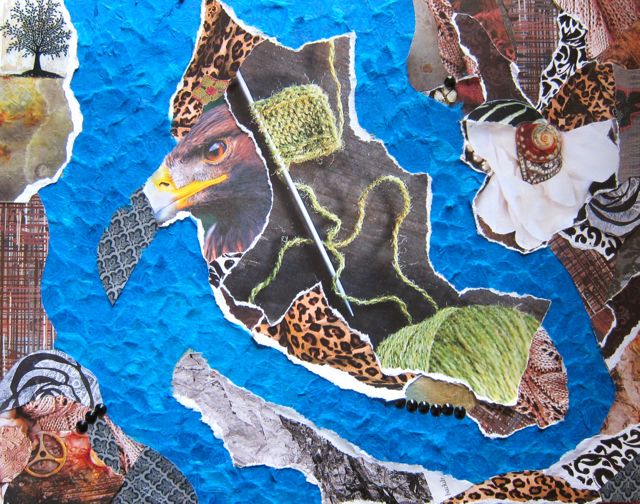
My eagle collage depicts a rare species of knitted raptor, a bird who is at home in the water as well as the sky. Much less predatory than its non-textile cousins, the knitted eagle enjoys a quiet life of introspection.
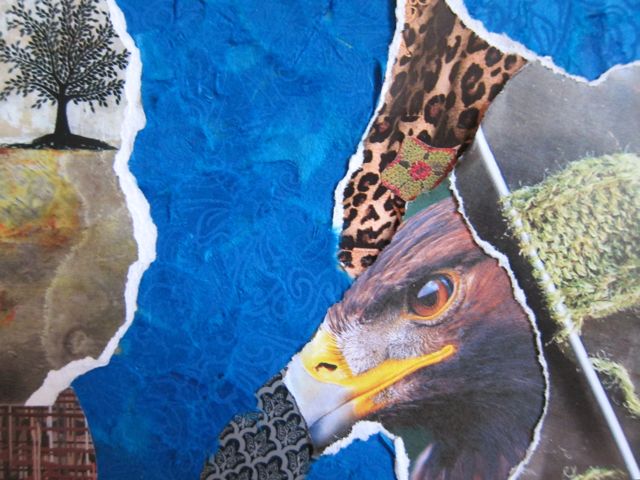
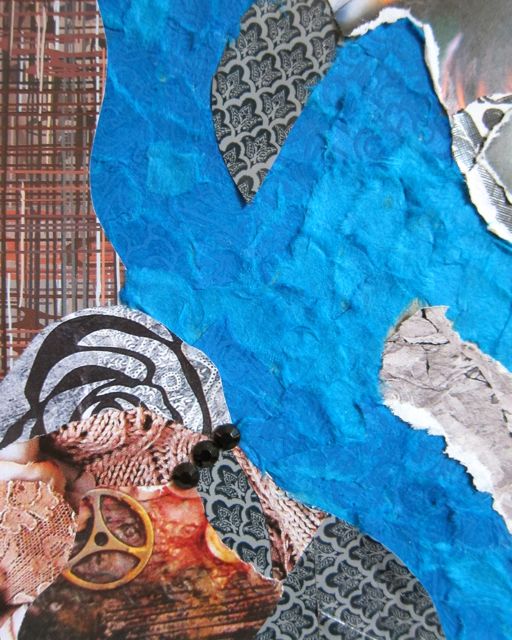
Several months after Mom’s visit, my friend Noreia and I consulted the animal spirit guides and made collages in a North York food court. This time, the card I picked belonged to Raven.
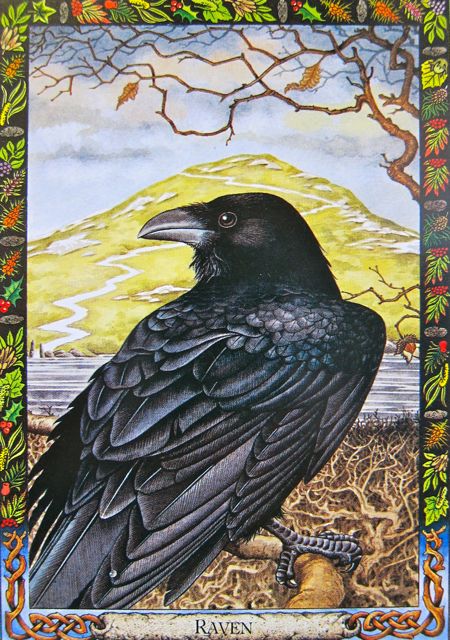
Raven represents “Healing, Initiation, (and) Protection,” and its message “may . . . mean that we can come to a resolution of the opposites — experiencing that in darkness there is light, and in light darkness” (p. 20).
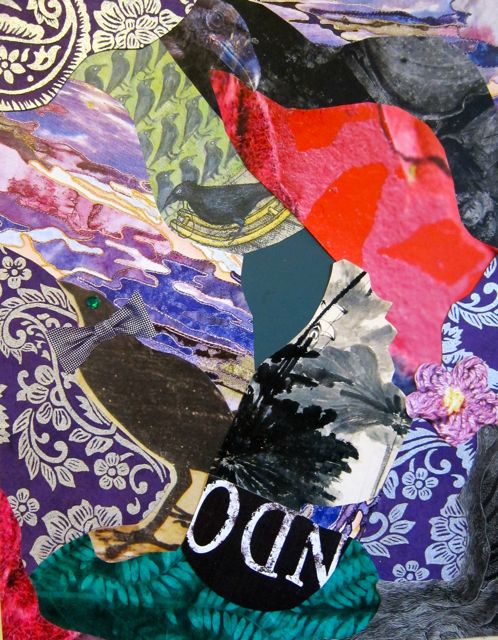
In my collage, three ravens consider life among the swirling patterns, discerning mysteries with their keen eyes.
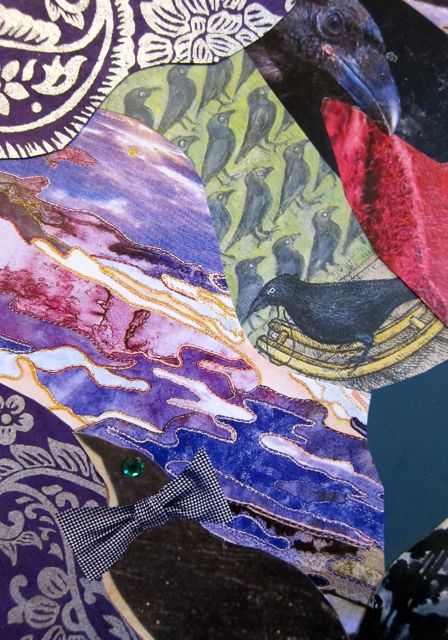
A subsequent session with Noreia saw us spreading out collage materials and the deck on a large wooden table at Balzac’s Coffee Roasters. I chose Frog, whose key words are “Sensitivity, Medicine, and Hidden Beauty and Power” and who reminds us to “look for the beauty and the magic behind appearances” (p. 19).
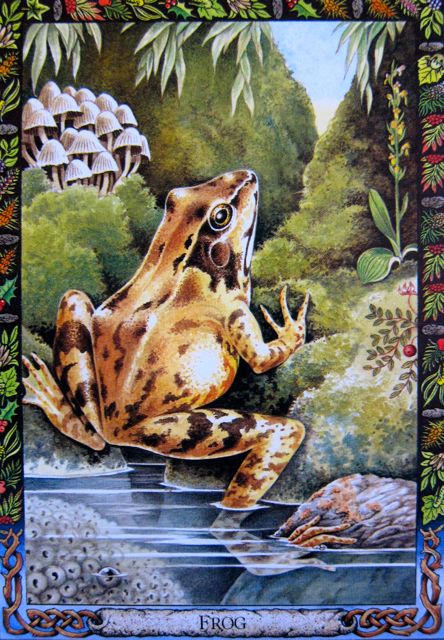
Carr-Gomm’s booklet also states that Frog is “a companion of the rain spirits” who can “help you develop your sensitivity to others, to healing and to sound through your skin and your whole body” (p. 19).
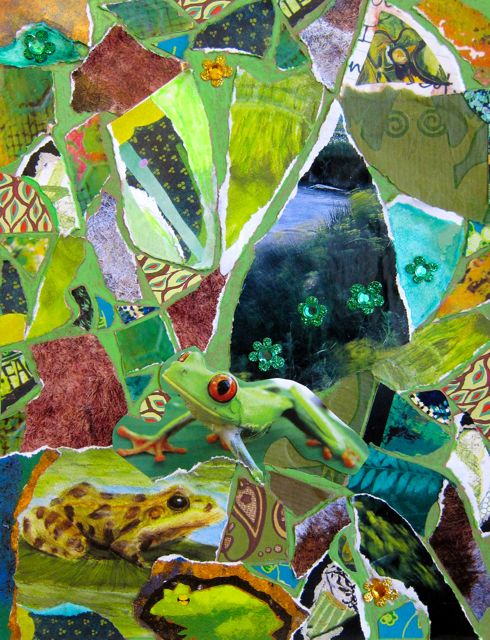
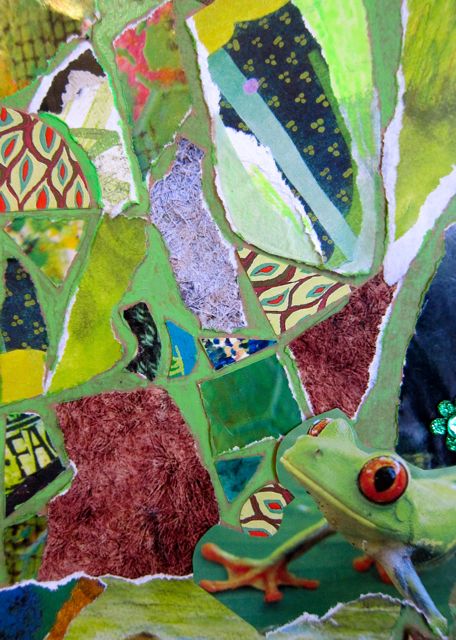
Goose followed Frog as the next creature-collage inspired by The Druid Animal Oracle Deck. At Noreia’s suggestion, we auditioned a different wooden table at a new coffee shop for the session, and it proved to be a goose-friendly venue.
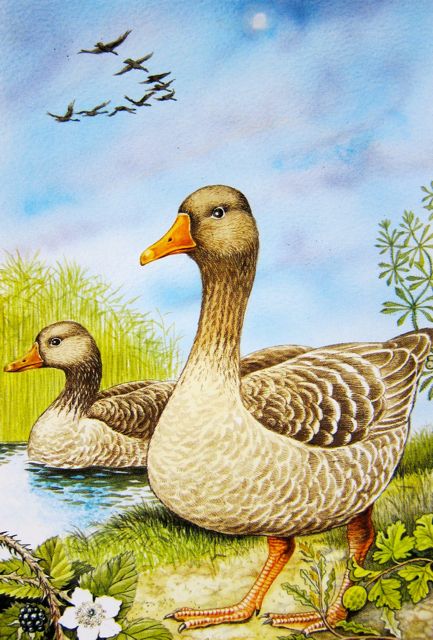
When I turned to the booklet’s page about Goose, I discovered that its main attributes are “Vigilance, Parenthood, (and) Productive Power” (p. 27). Additionally, Goose’s talent for attentive parenthood and soaring flight “shows us that it is possible to be both grounded and spiritual in our daily lives” (p. 27).
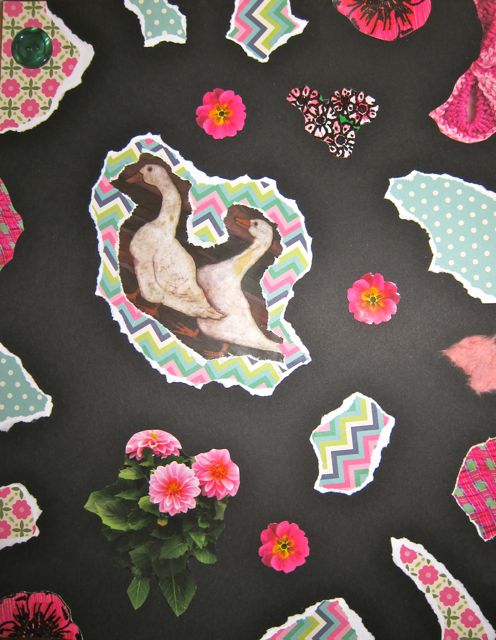
After Goose, Seal surfaced as the next animal spirit mentor during an oracle session that Noreia and I conducted at a home retreat.
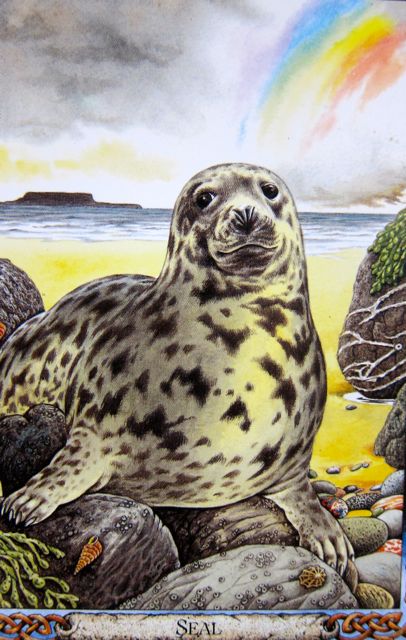
Symbolizing “Love, Longing, and Dilemma,” Seal can “act as a guide and companion through the watery realm of the emotions and the Otherworld” (p. 40).
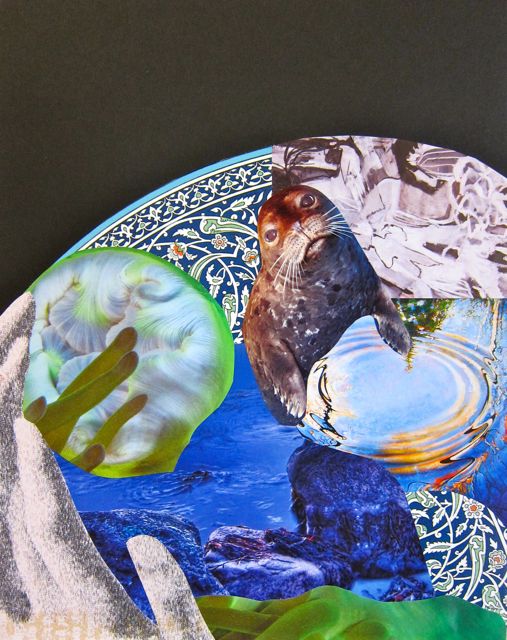
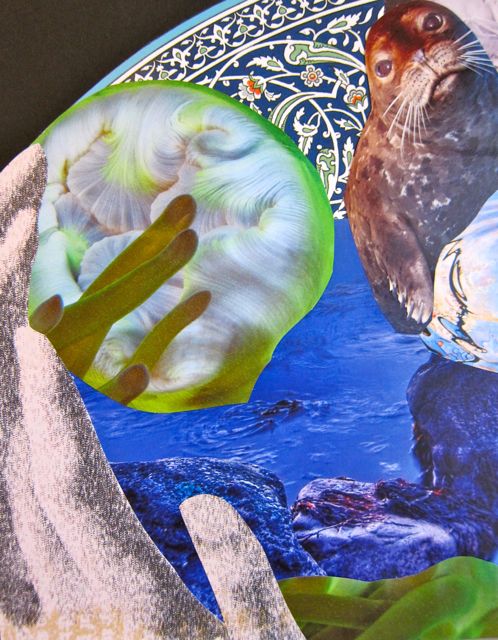
Cat followed Seal to serve as a guide in the series, and Carr-Gomm’s booklet explains that “Cat brings us the ability to observe situations quietly, without judgment, before making decisions” (p. 17).
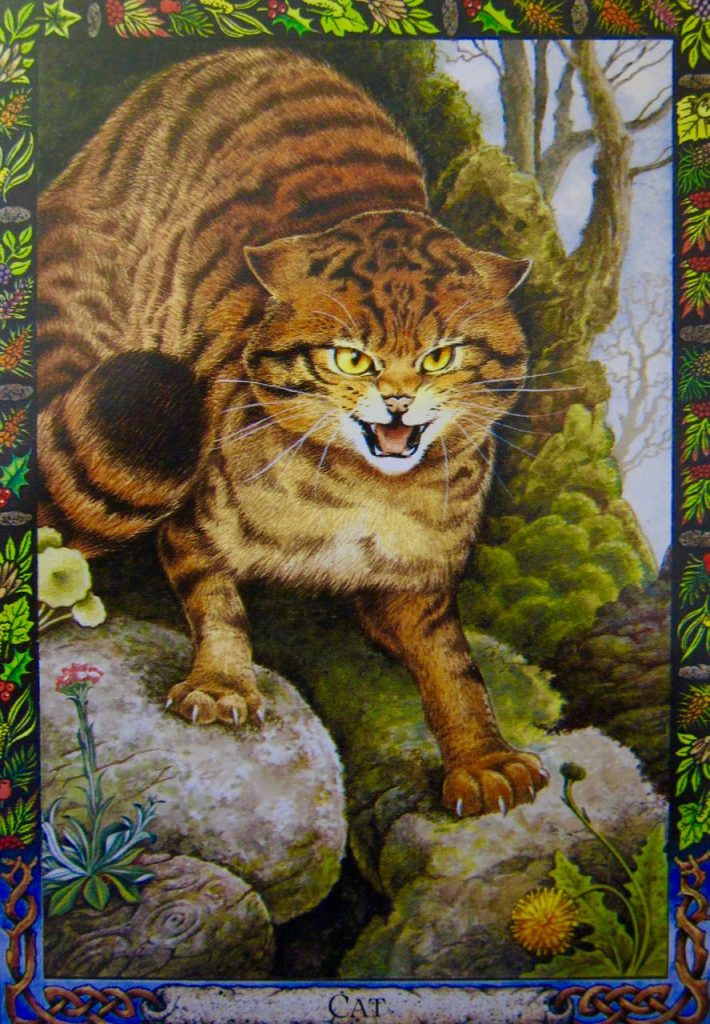
For Flying Flower Cat, a calm and grounded mind provides the ideal springboard for flight.
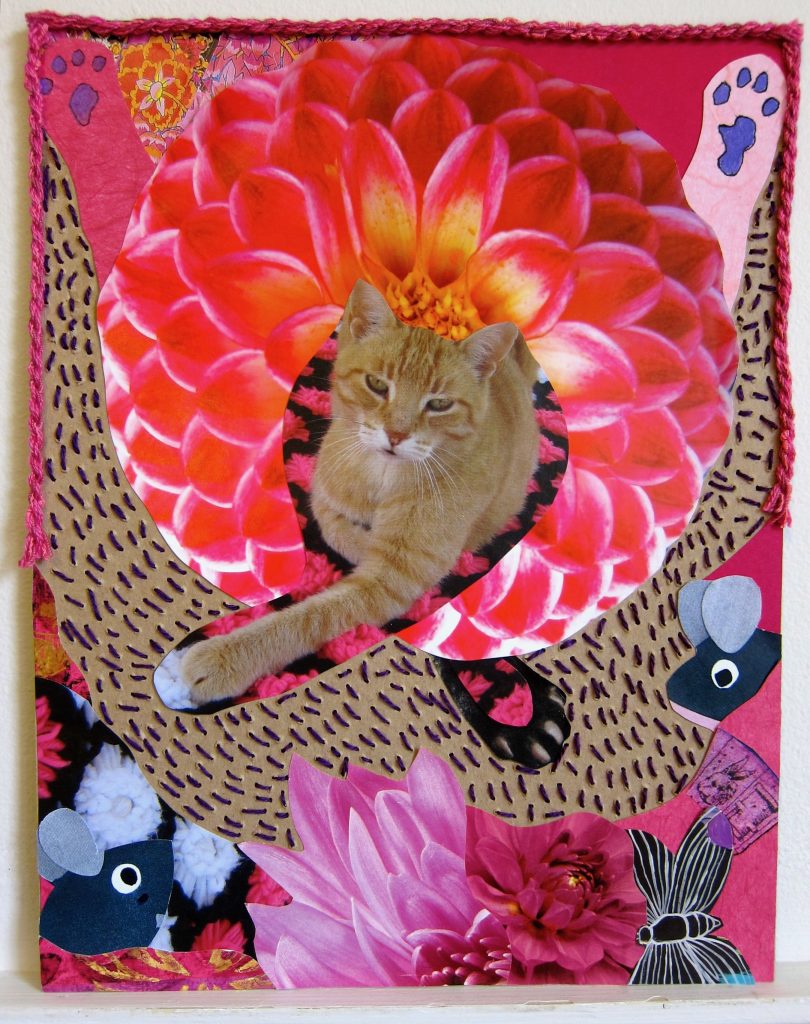
Finally, Salmon has been the most recent educator chosen from the deck, but other animals patiently wait for their turn to advise. As for the nine creatures who arrived from 2010 to 2016, I’d like to express my gratitude to Wolf, Otter, Eagle, Raven, Frog, Goose, Seal, Cat, and Salmon for their energizing insights and creativity!
2022 Update
Salmon’s collage is dedicated to the memory of Ellen S. Jaffe, who loved consulting The Druid Animal Oracle Deck and making art in community.
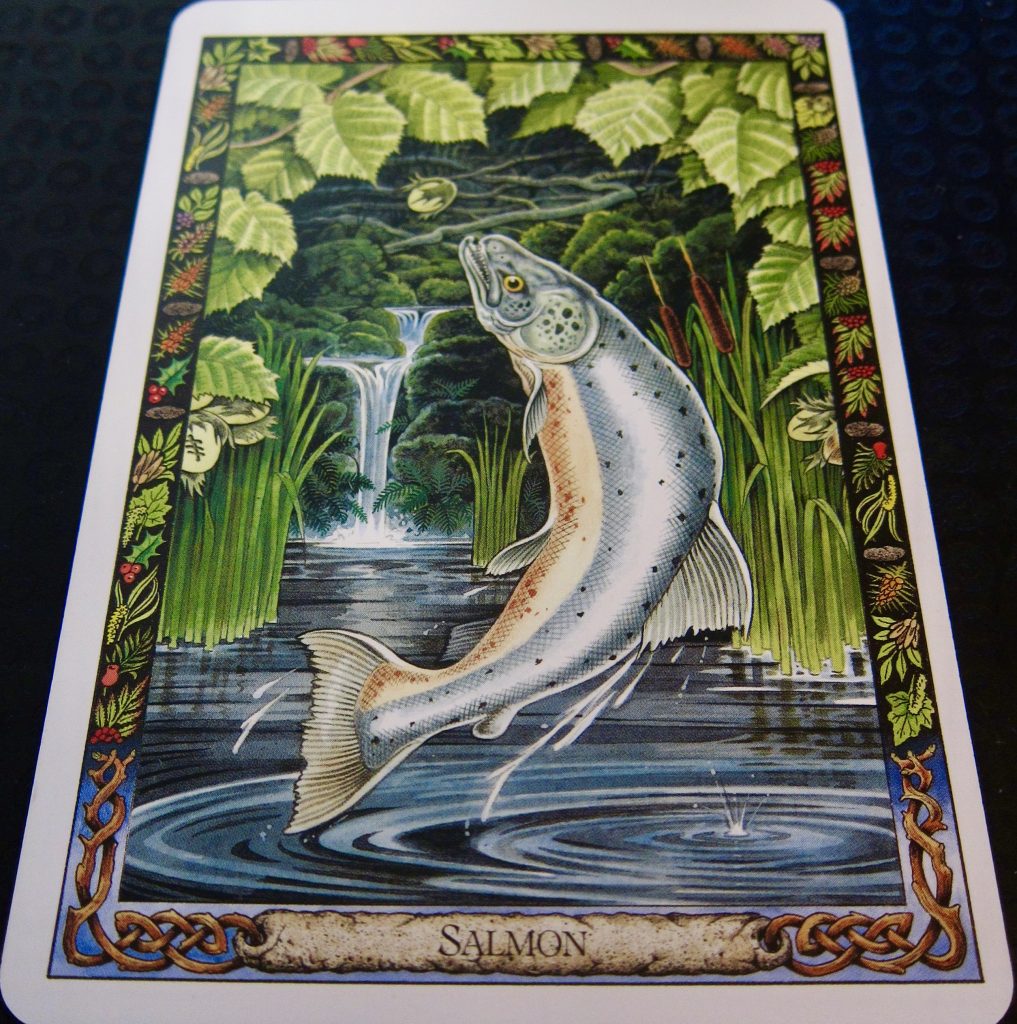 Illustrated by Bill Worthington
Illustrated by Bill WorthingtonAs the oracle deck’s booklet relates, Salmon responds to upstream challenges with “wisdom and inspiration” (p. 30), and Ellen exemplified this spirit when she wrote poems about living with (but not being defined by) cancer. Like Salmon, she created an arc of beauty in adversity: turning to the sanctuary of art, reciting poems in her head during scans and treatments, and imagining the counsel of her late father, a doctor.
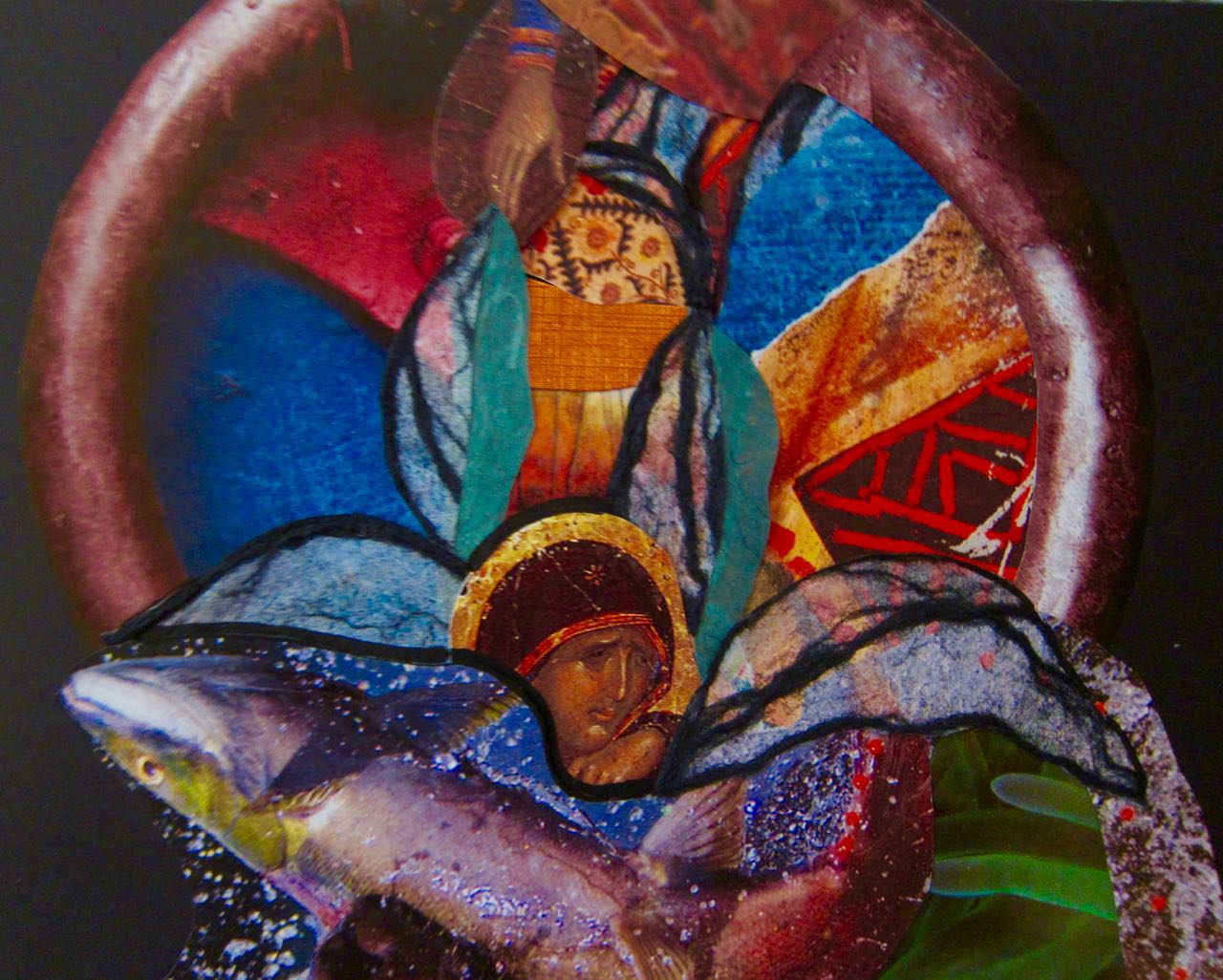 Seized by Loss, Catherine Raine 2016
Seized by Loss, Catherine Raine 2016Ellen died the day after her 77th birthday, cocooned in a cycle of return to her “beginnings . . . and perhaps beyond” (p. 30). While she was here with us, Ellen inspired, encouraged, and connected hearts with her poetry, activism, counseling, teaching, mothering, and friendship. For example, after hearing news of my grandmother’s death in 2008, Ellen introduced me to the phrase, “May her memory be a blessing,” explaining that it is a Jewish prayer to comfort the family of the deceased. Her compassionate words consoled me then and return to me now with a message of solace.
Ellen’s example shows what it means to live a life that blesses others, and in her legacy “lives the dearest freshness deep down things” (G. Hopkins’ God’s Grandeur, 1877) that soften the pain of loss. Ellen, thank you for being my friend and mentor. Your memory blesses, has blessed, and will bless us for generations.